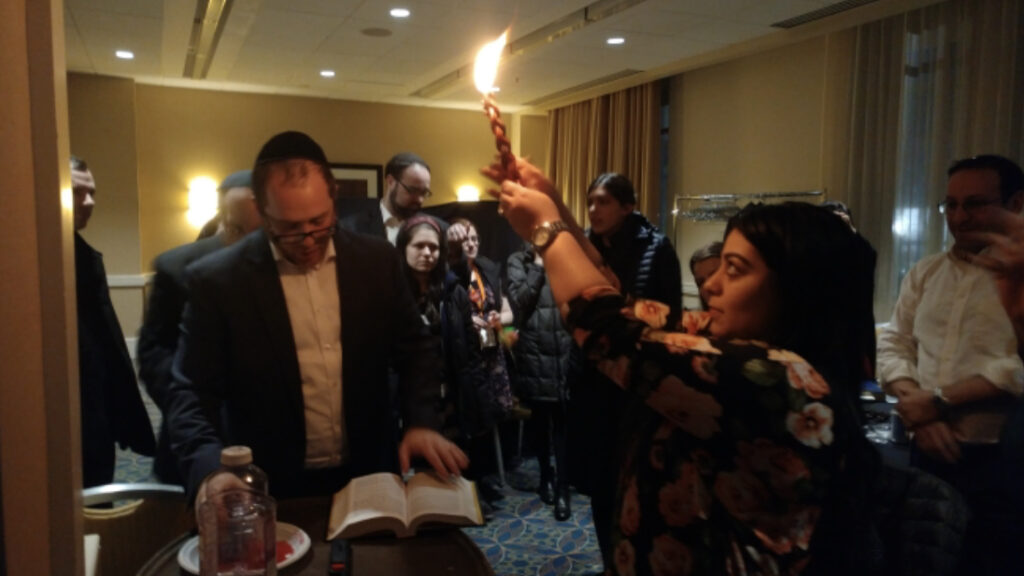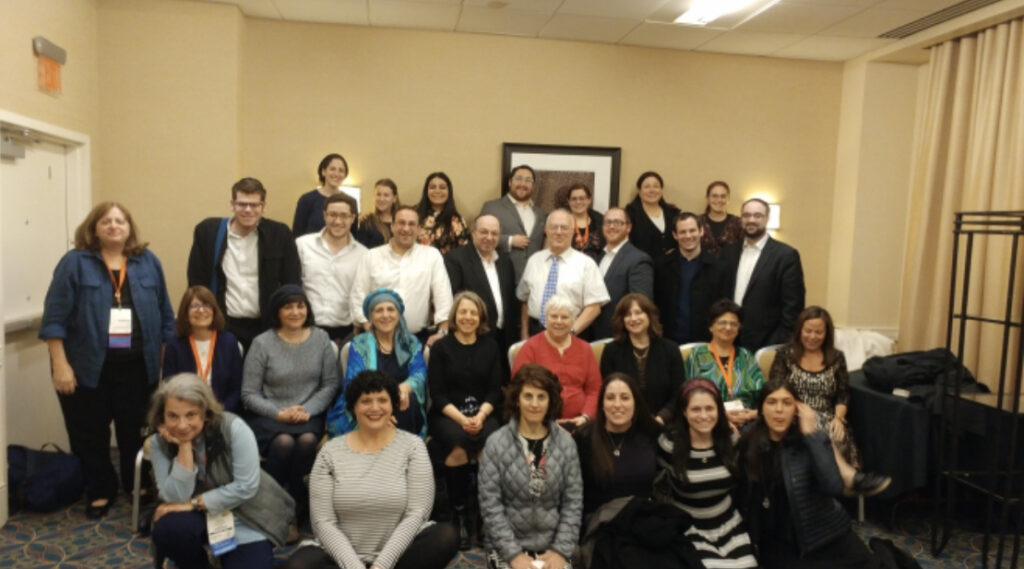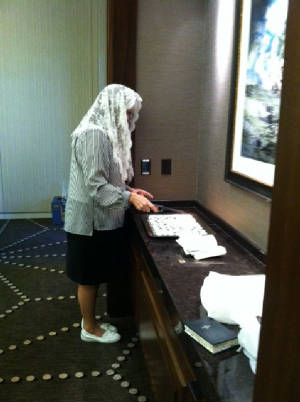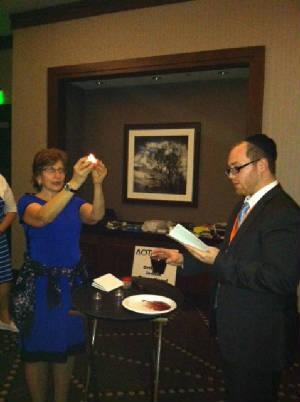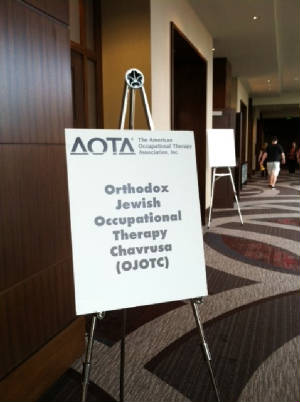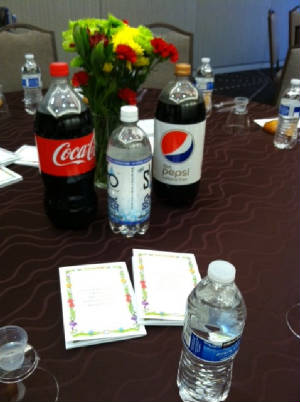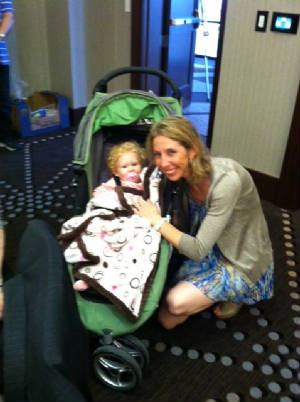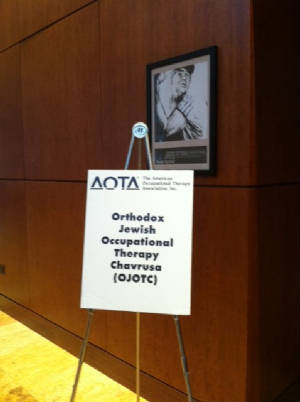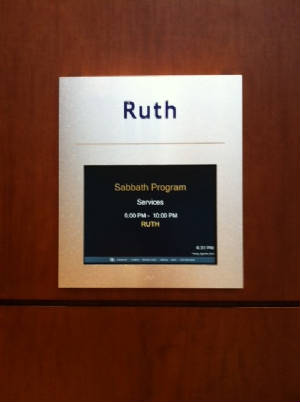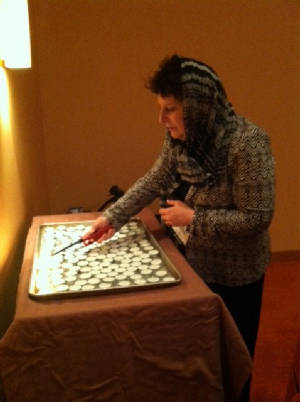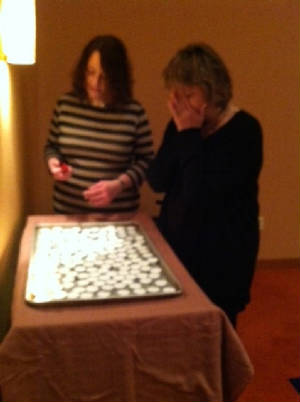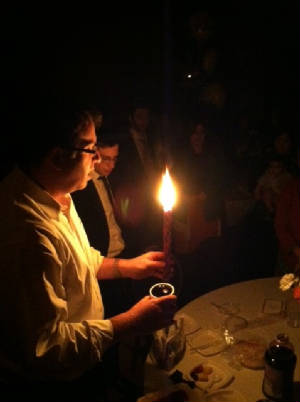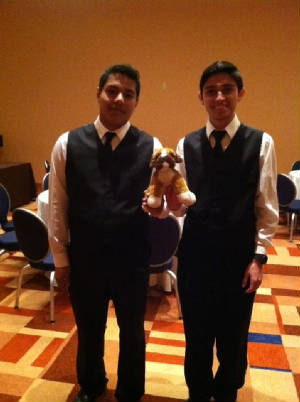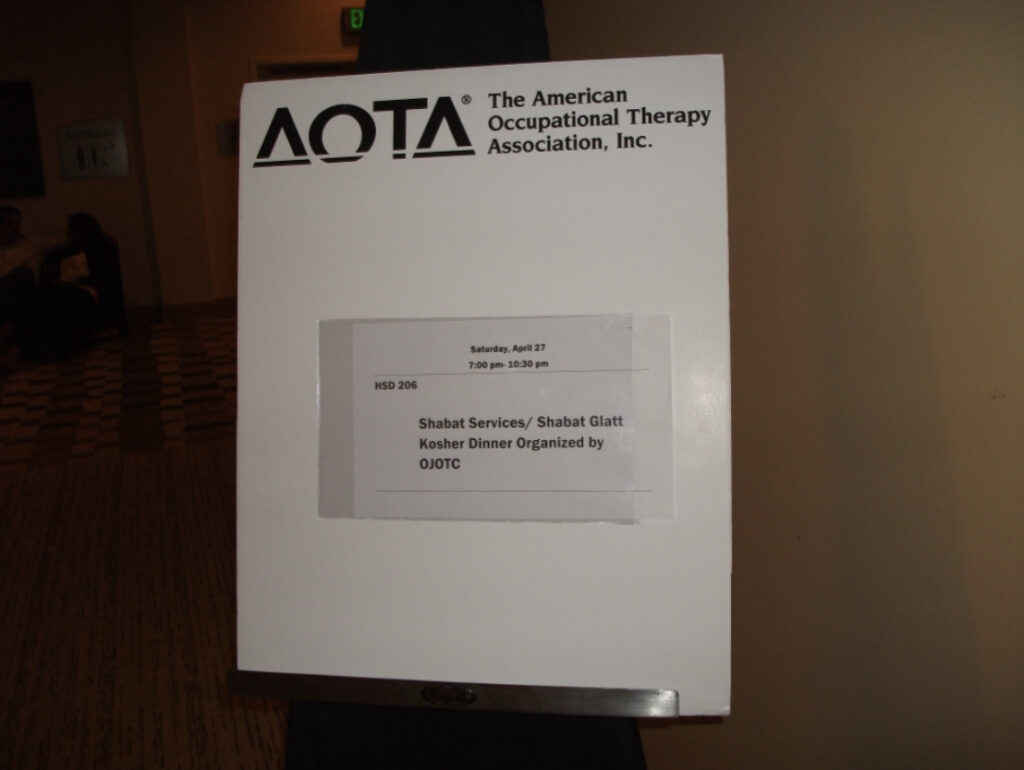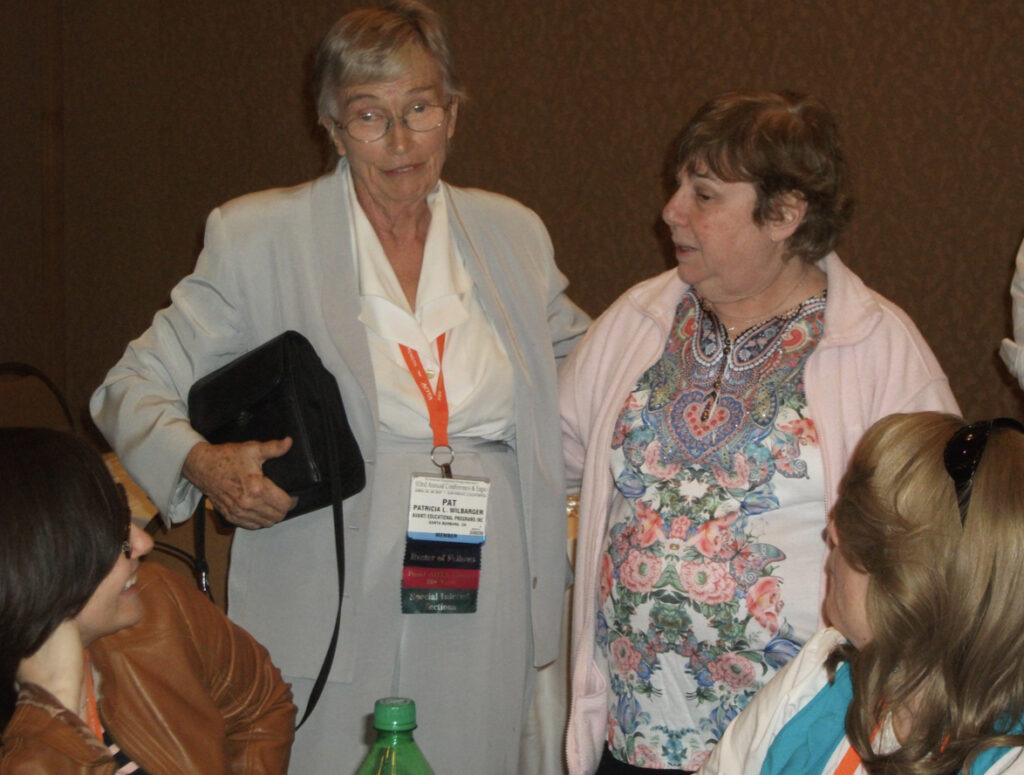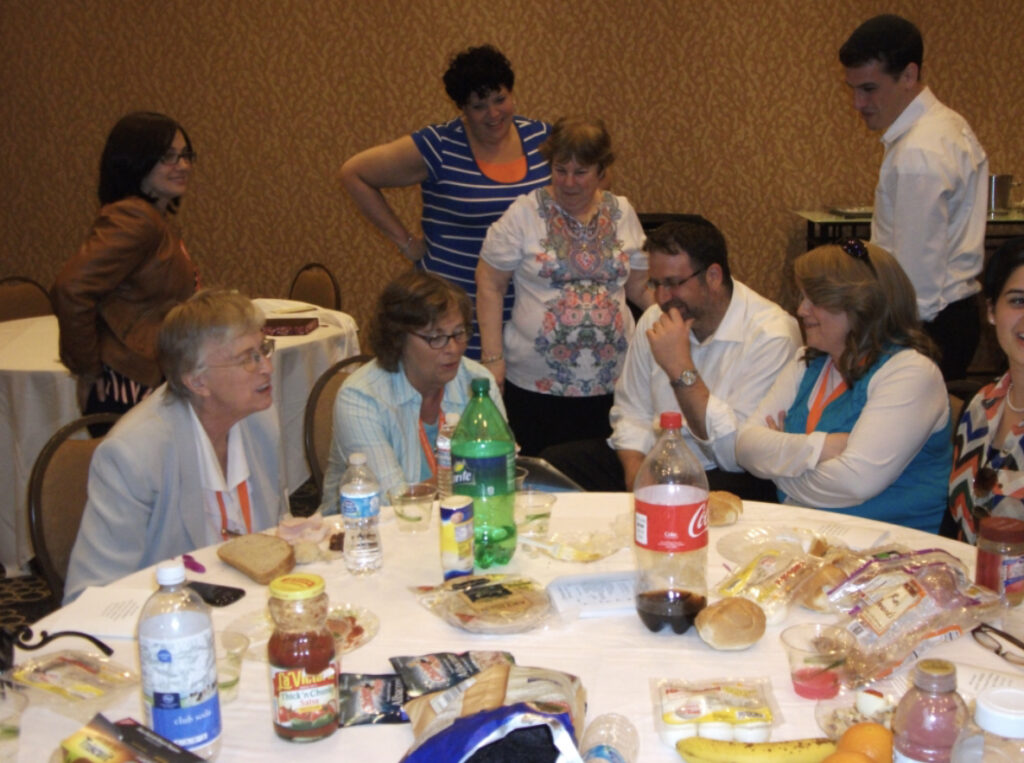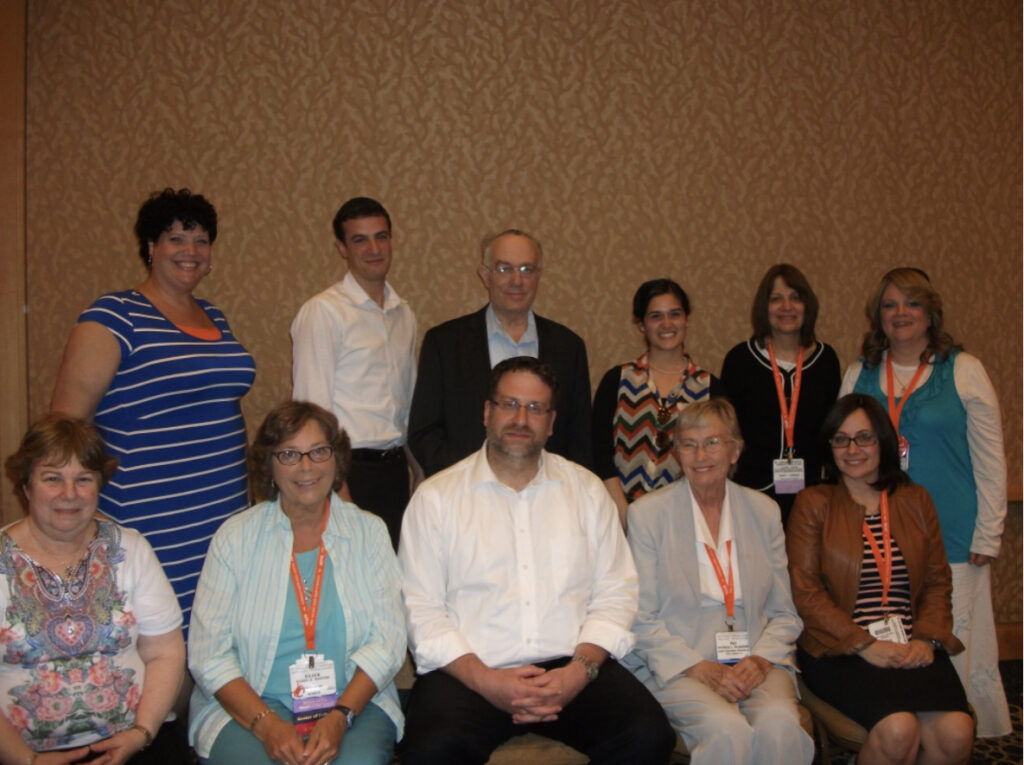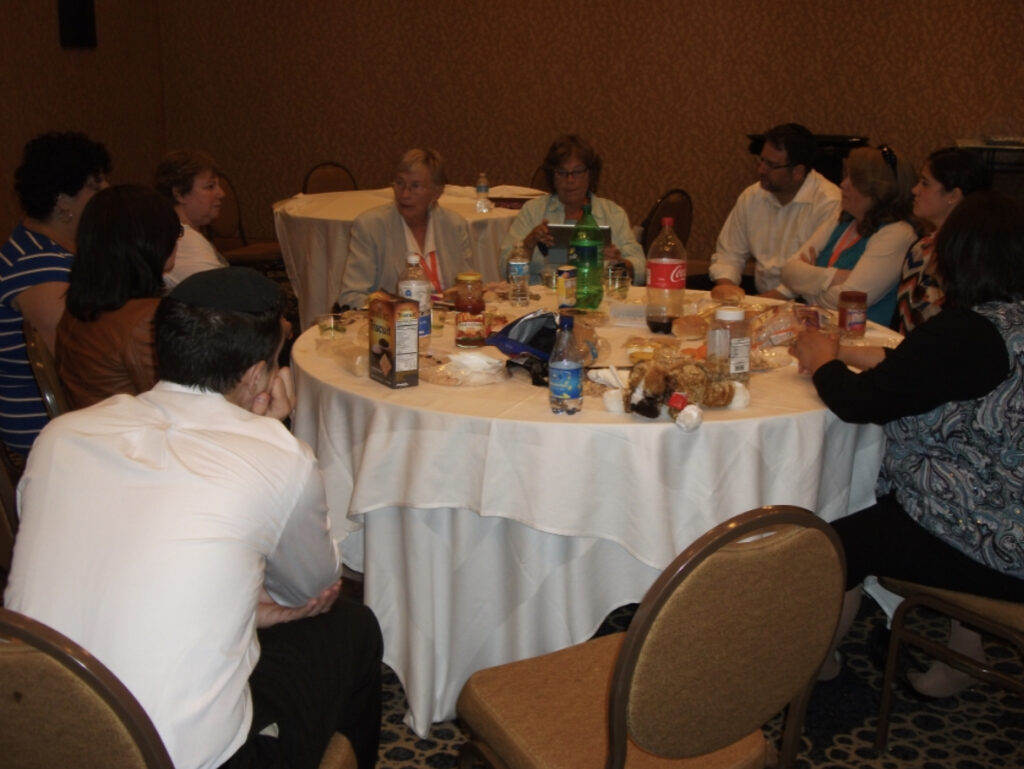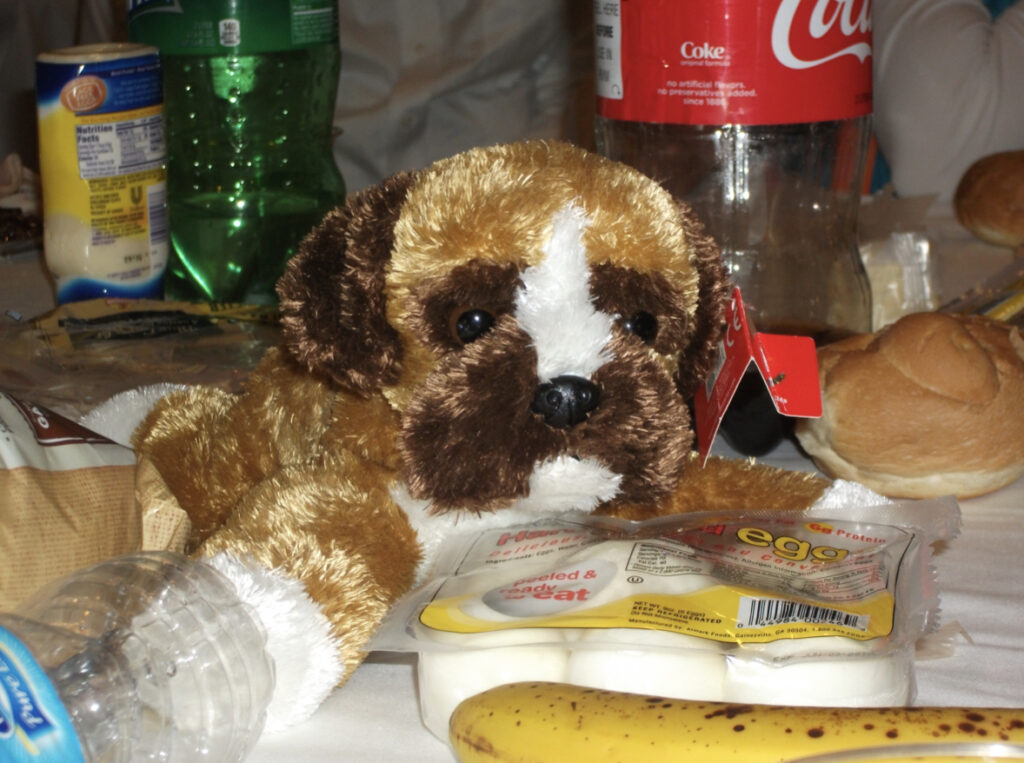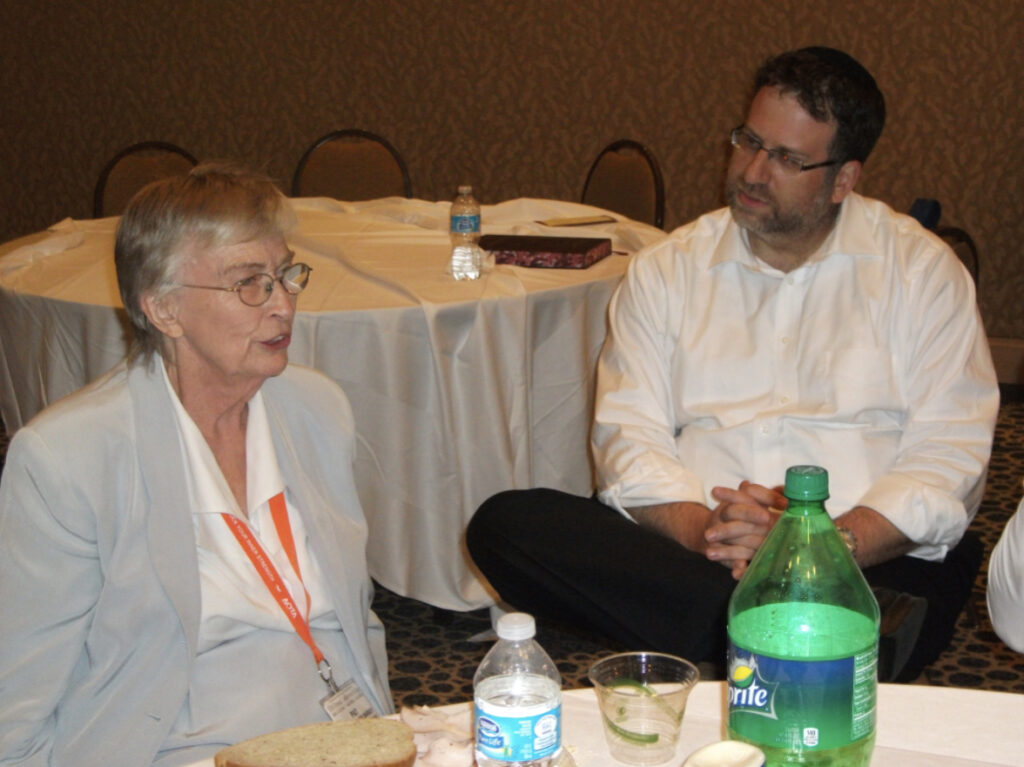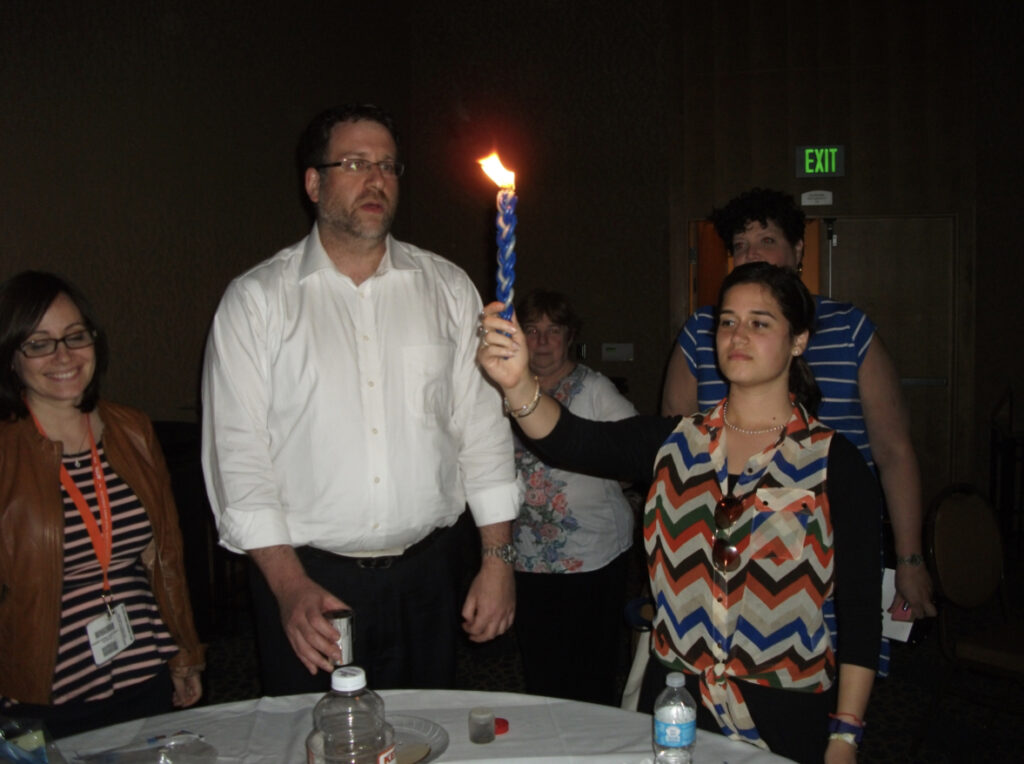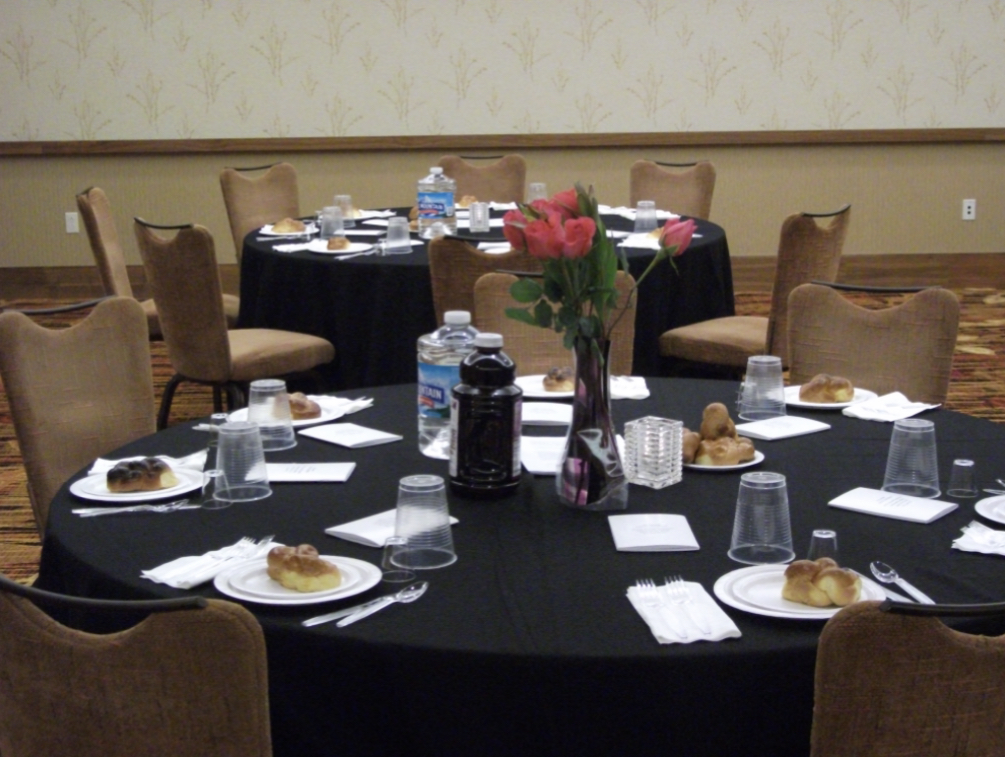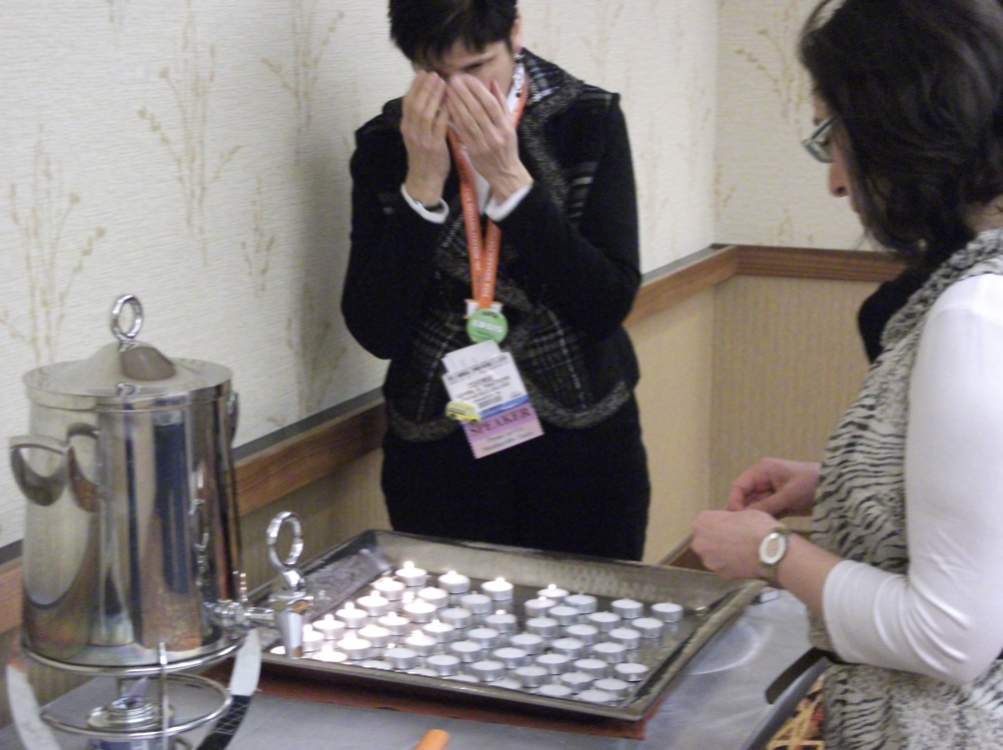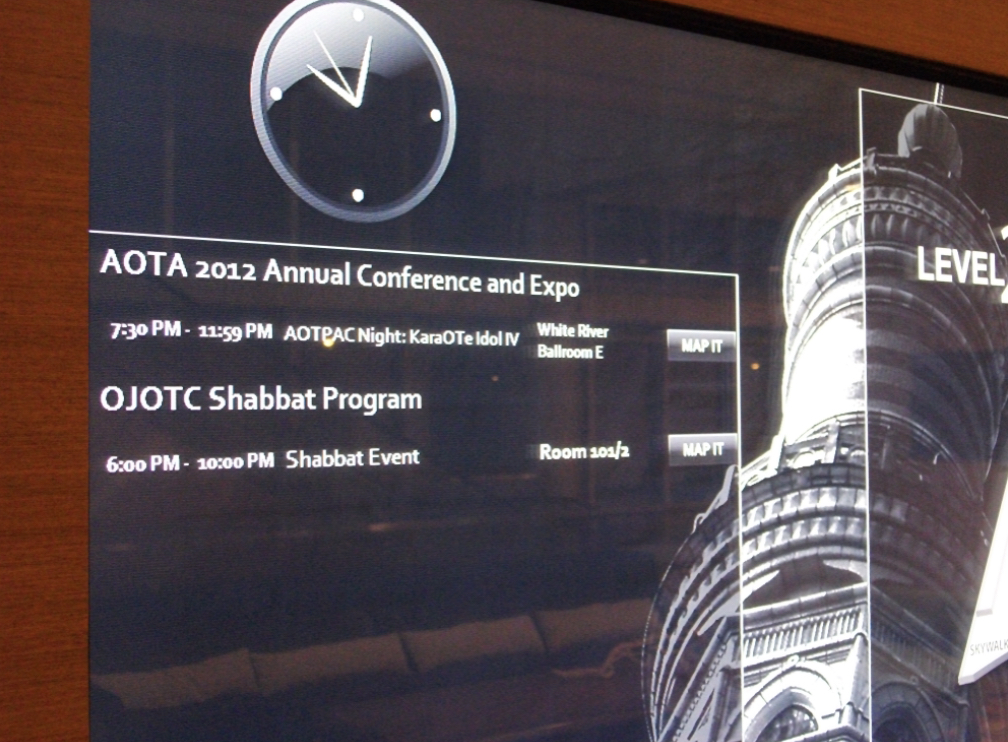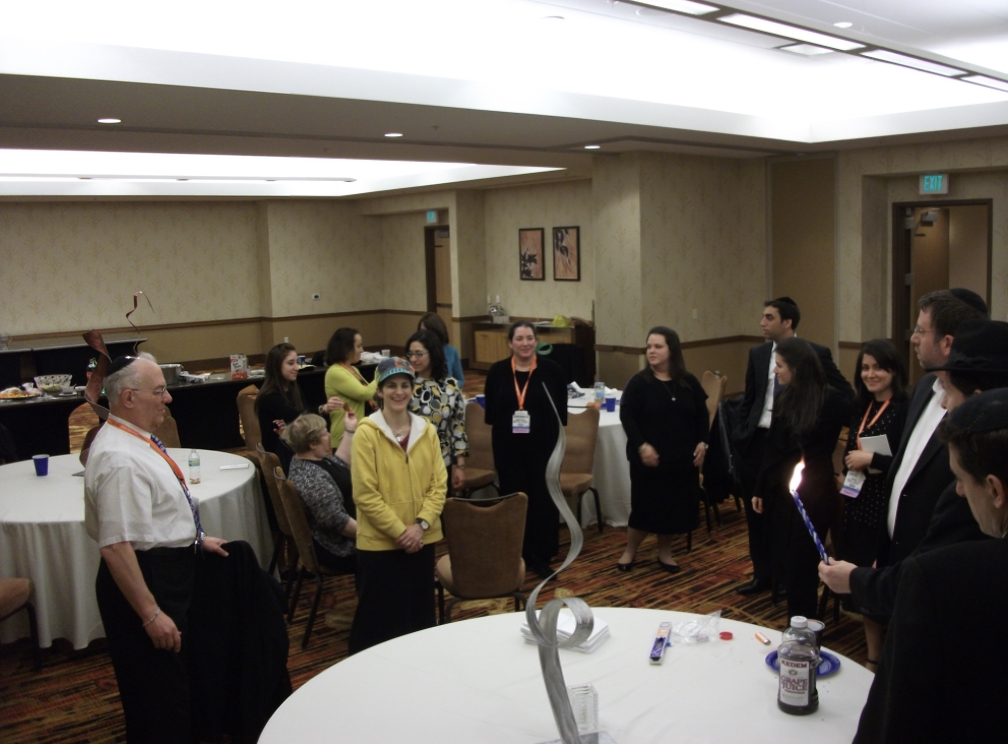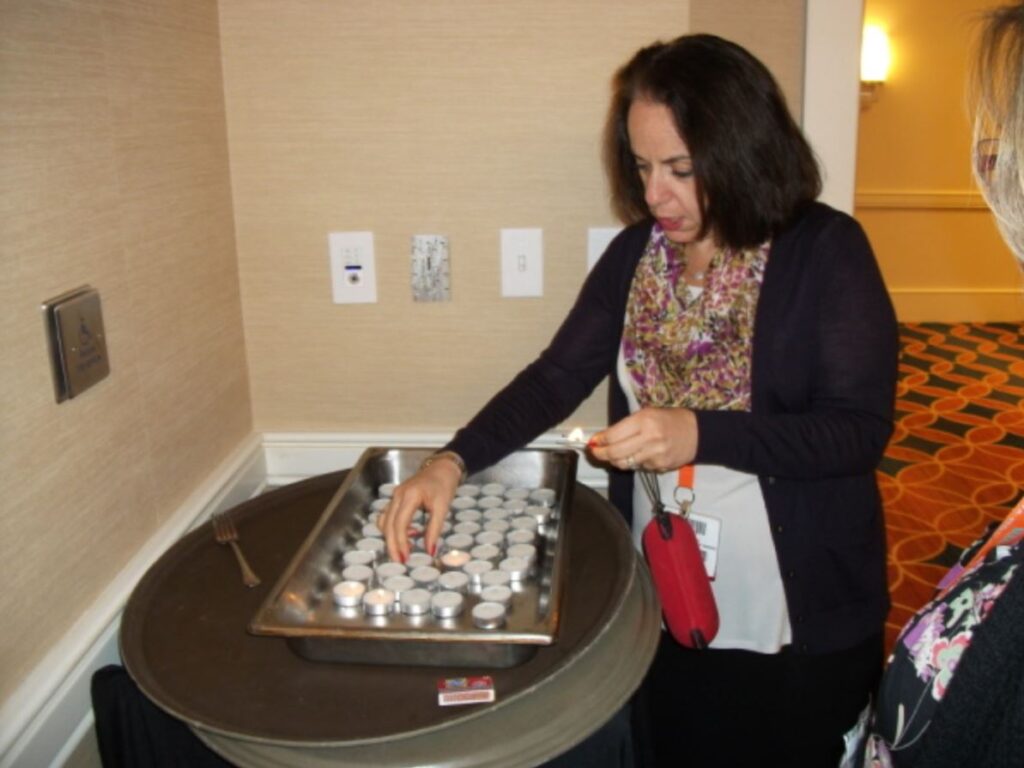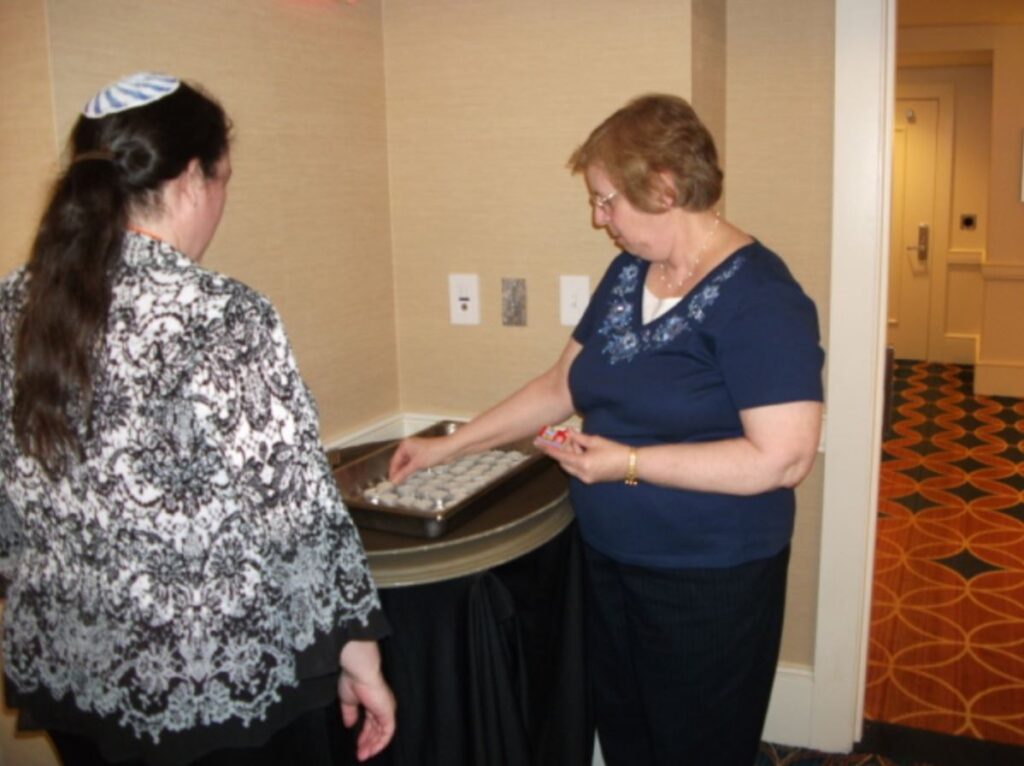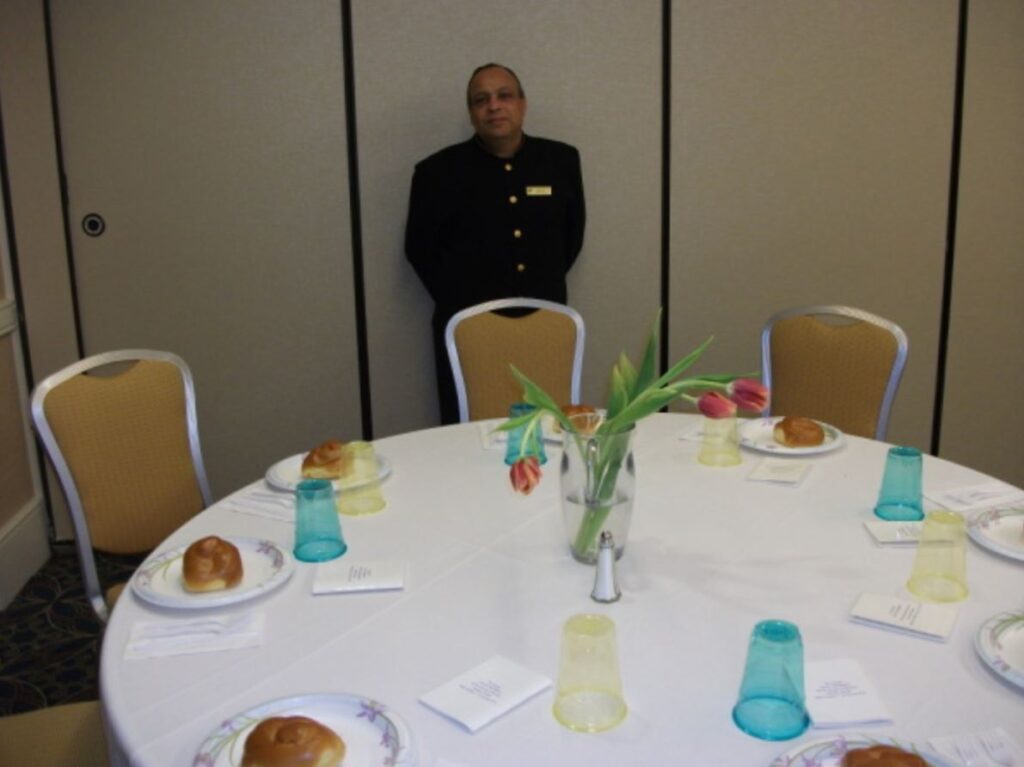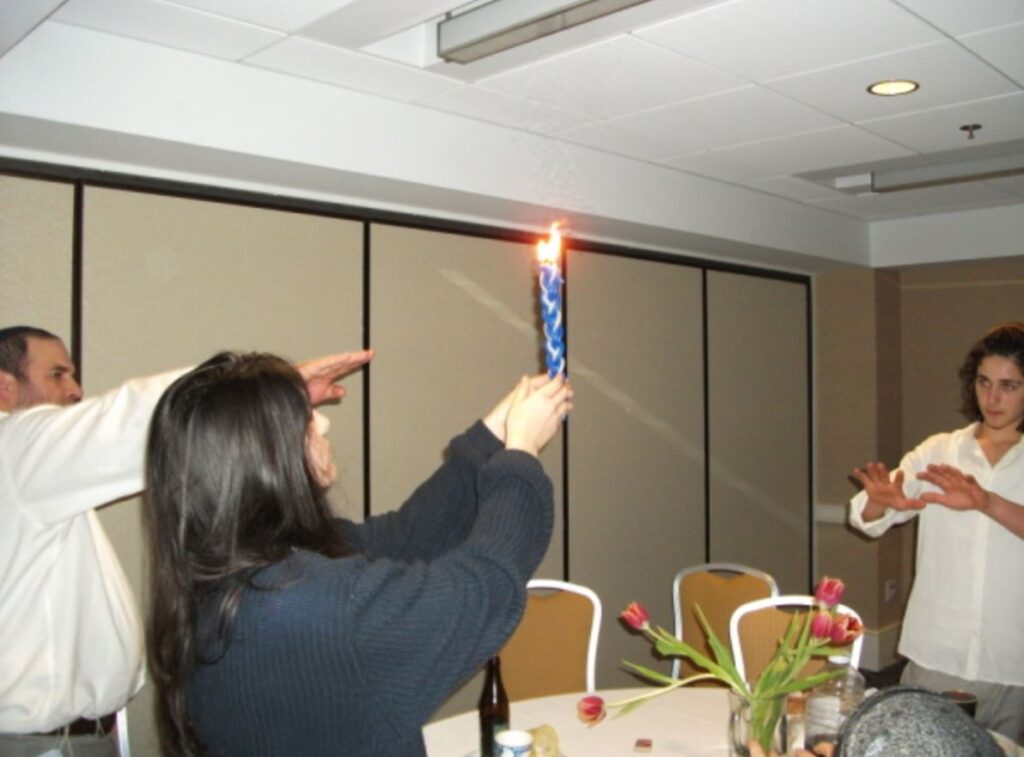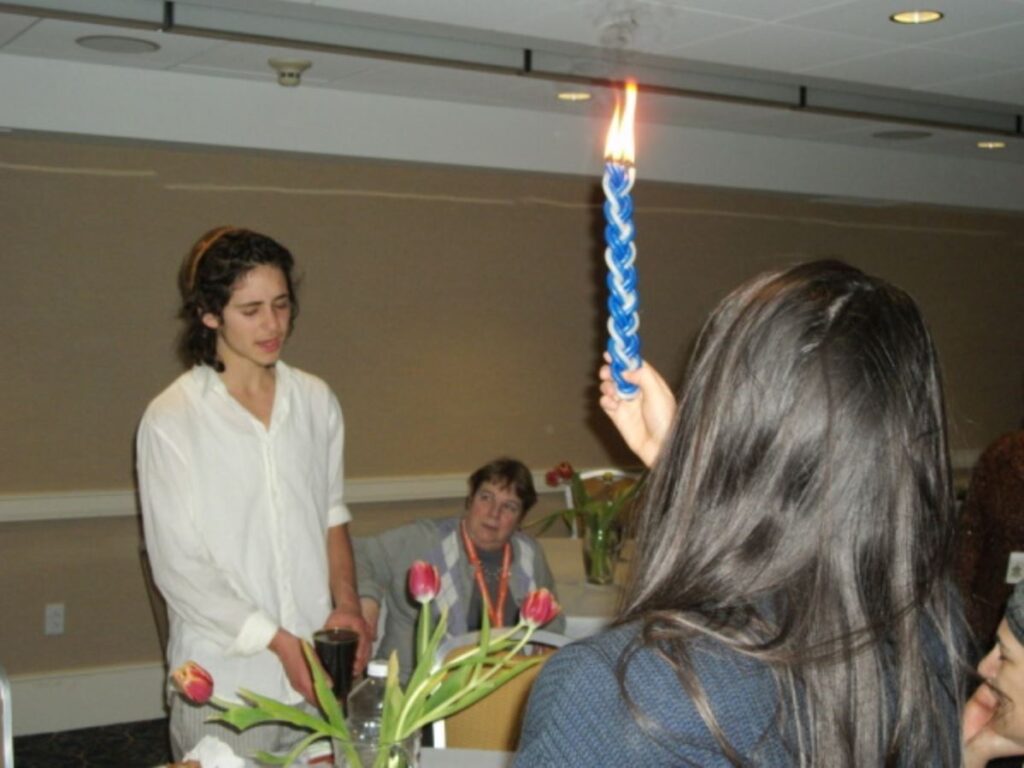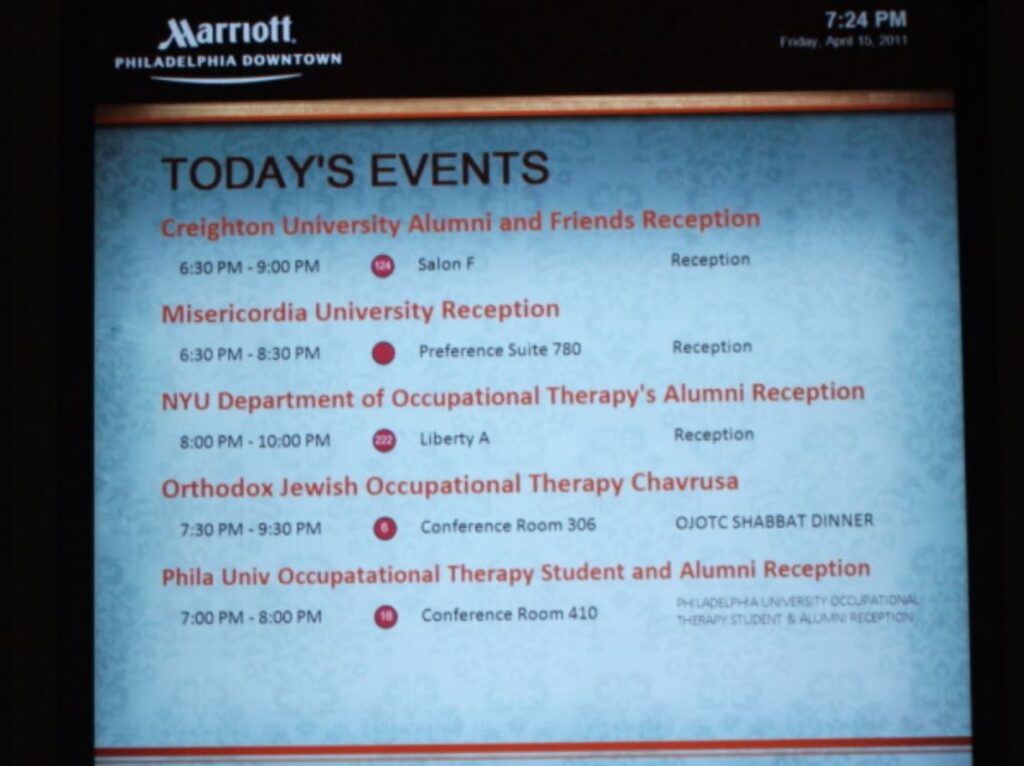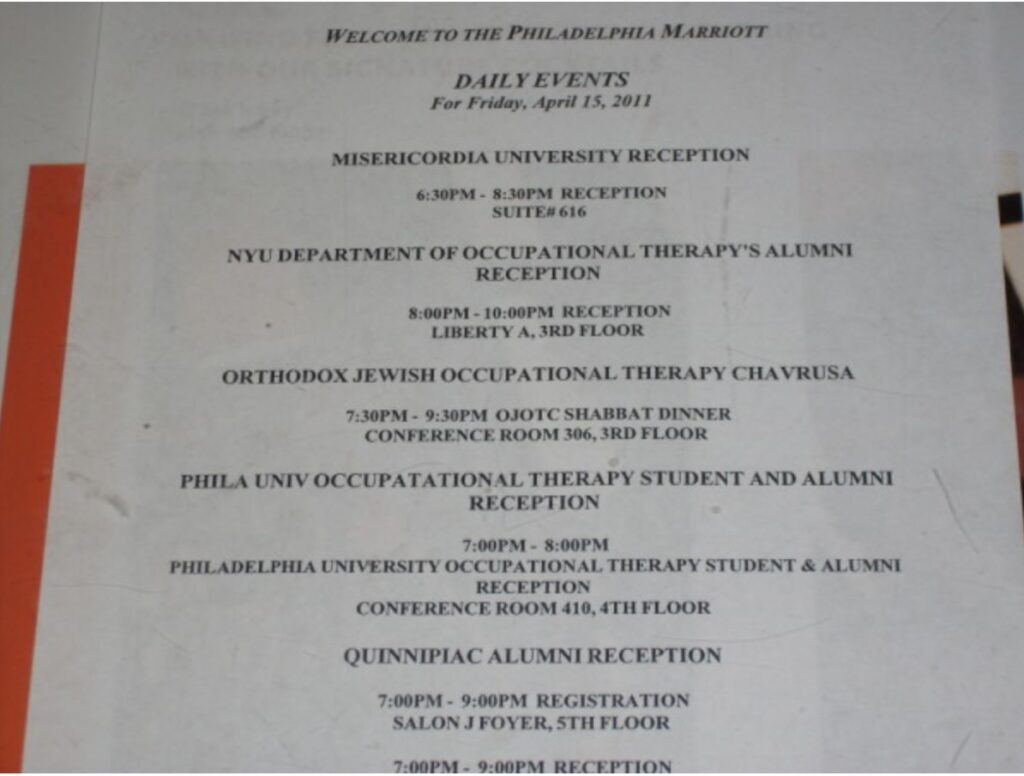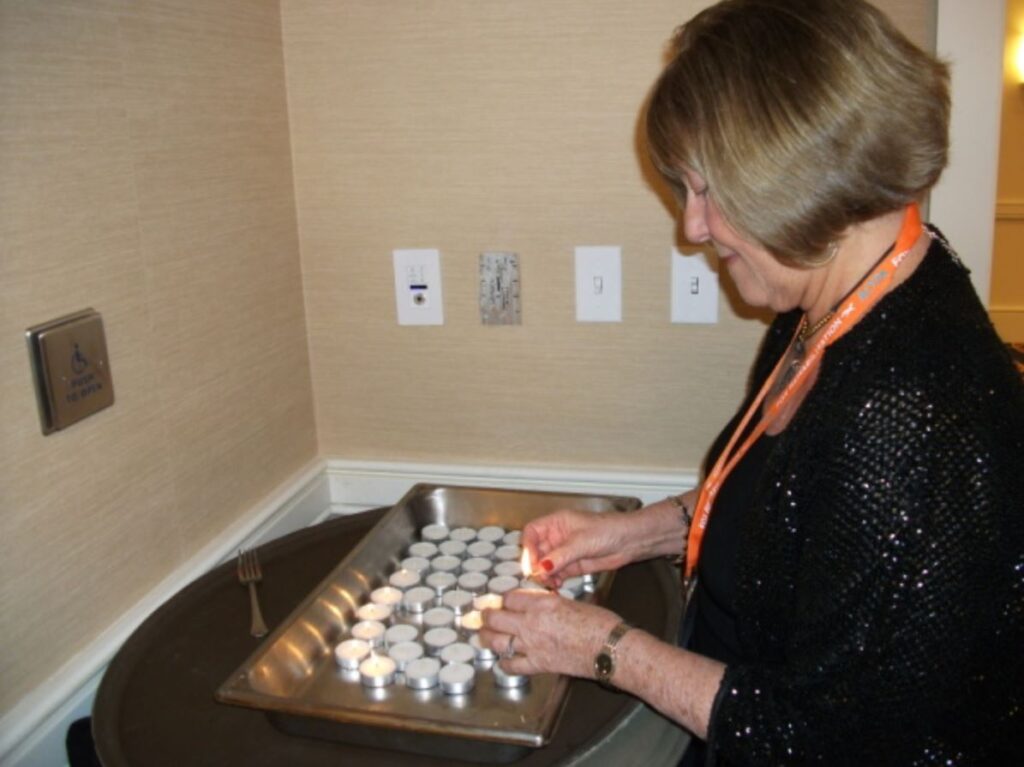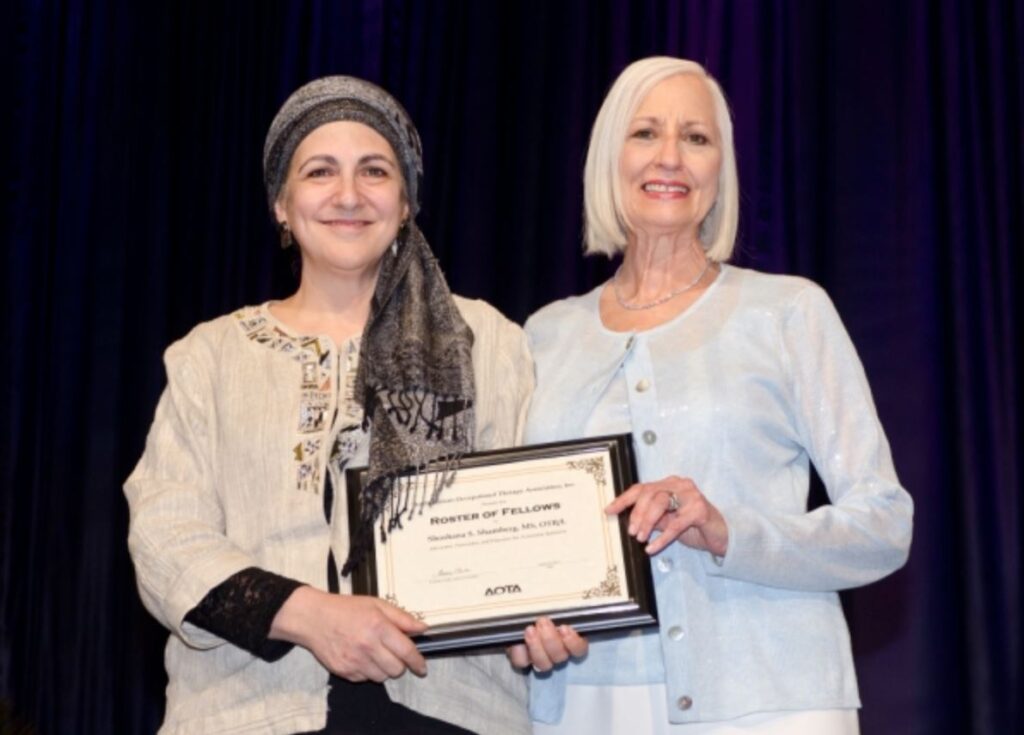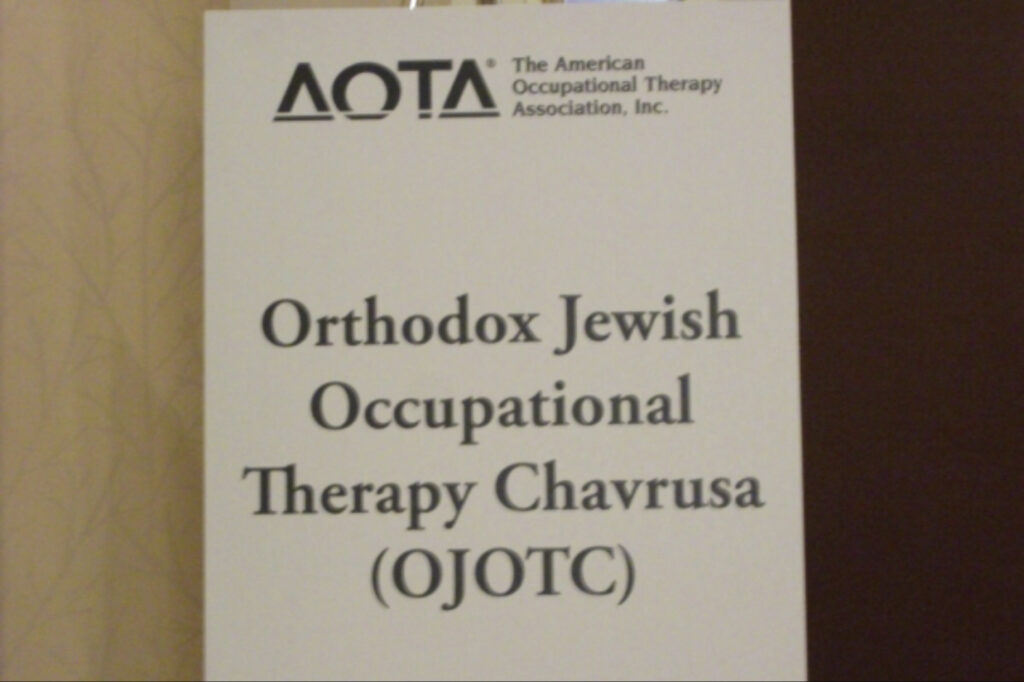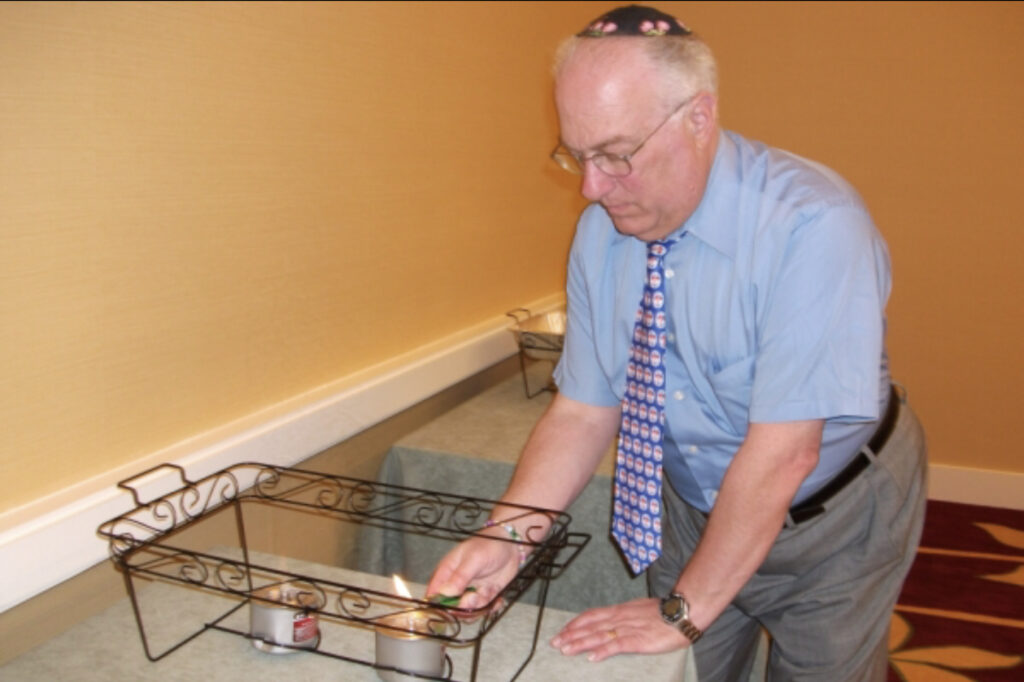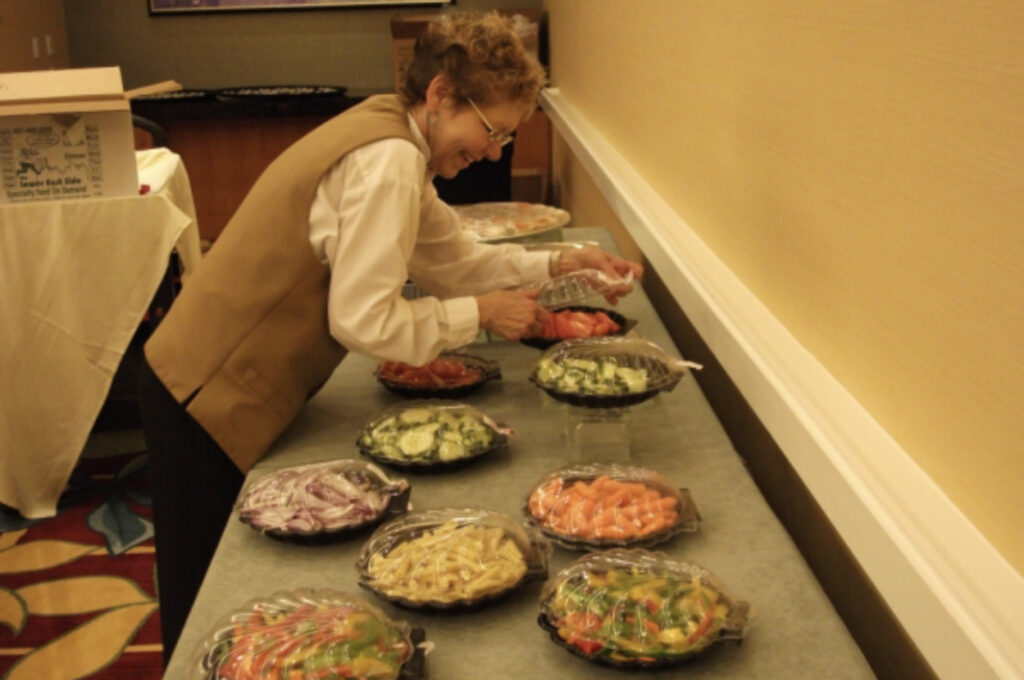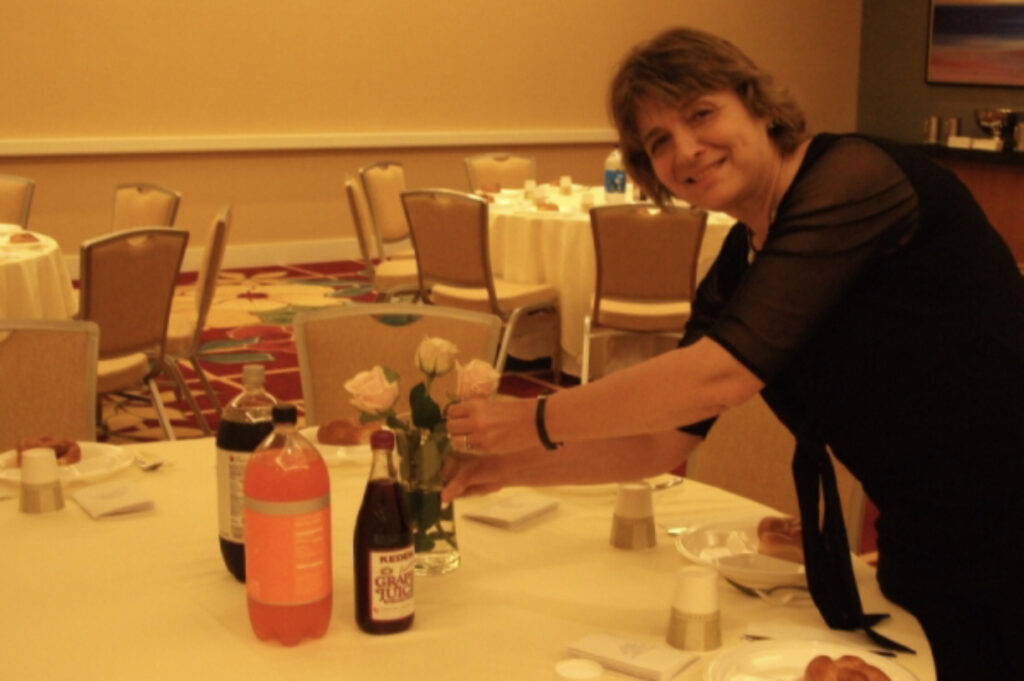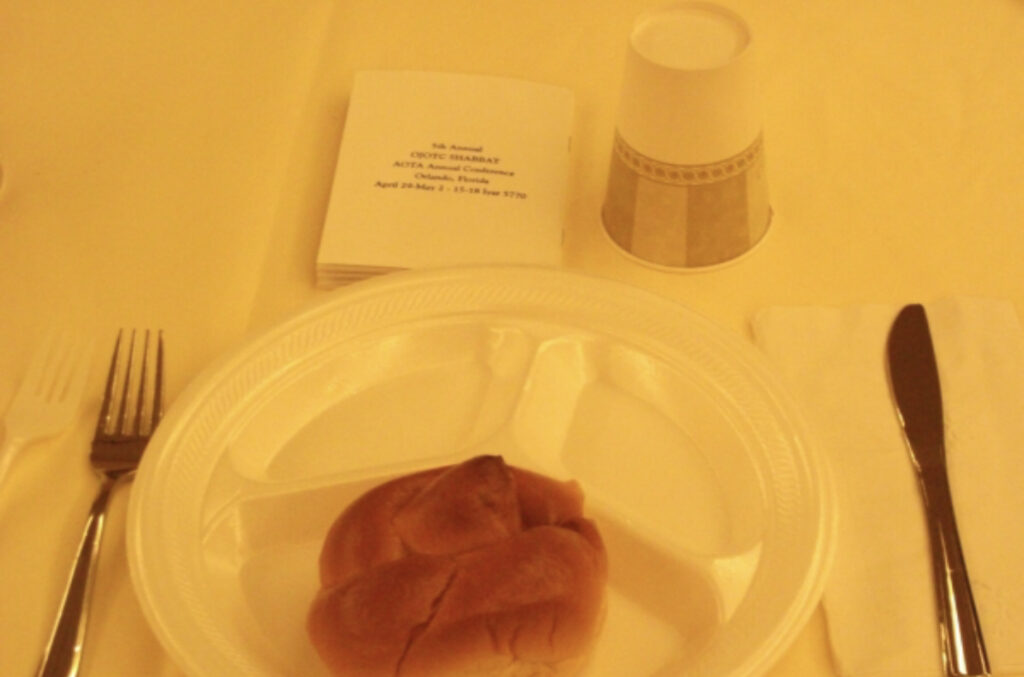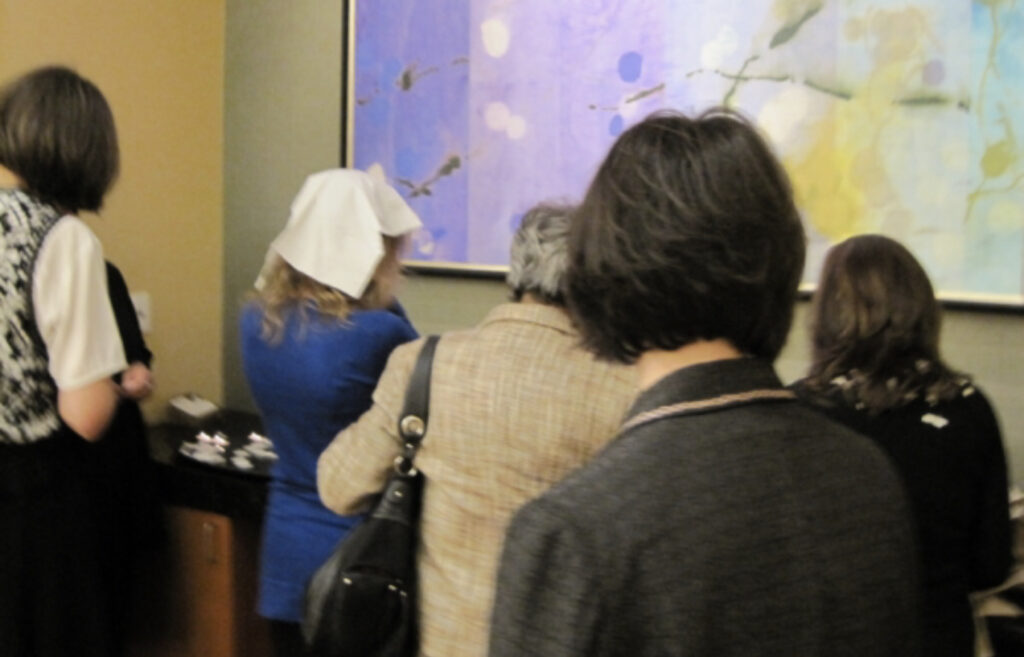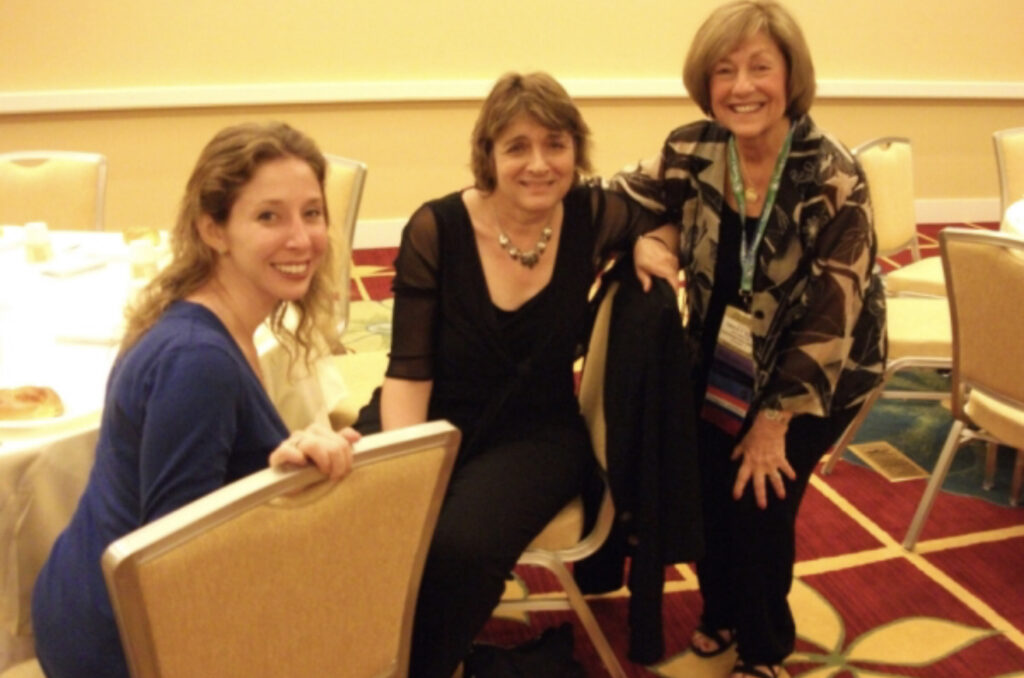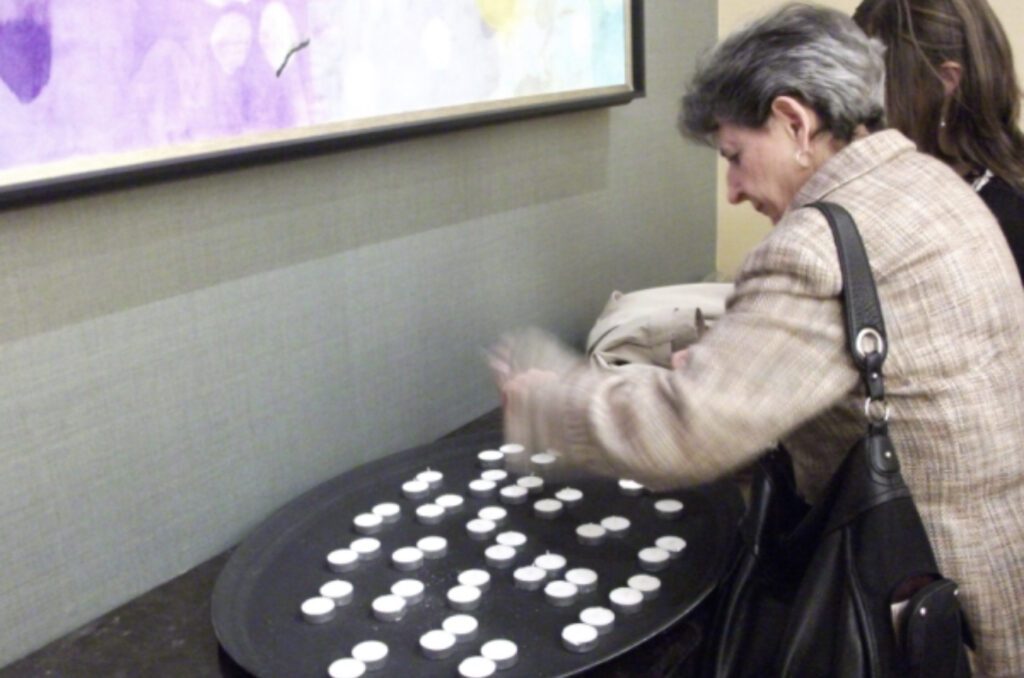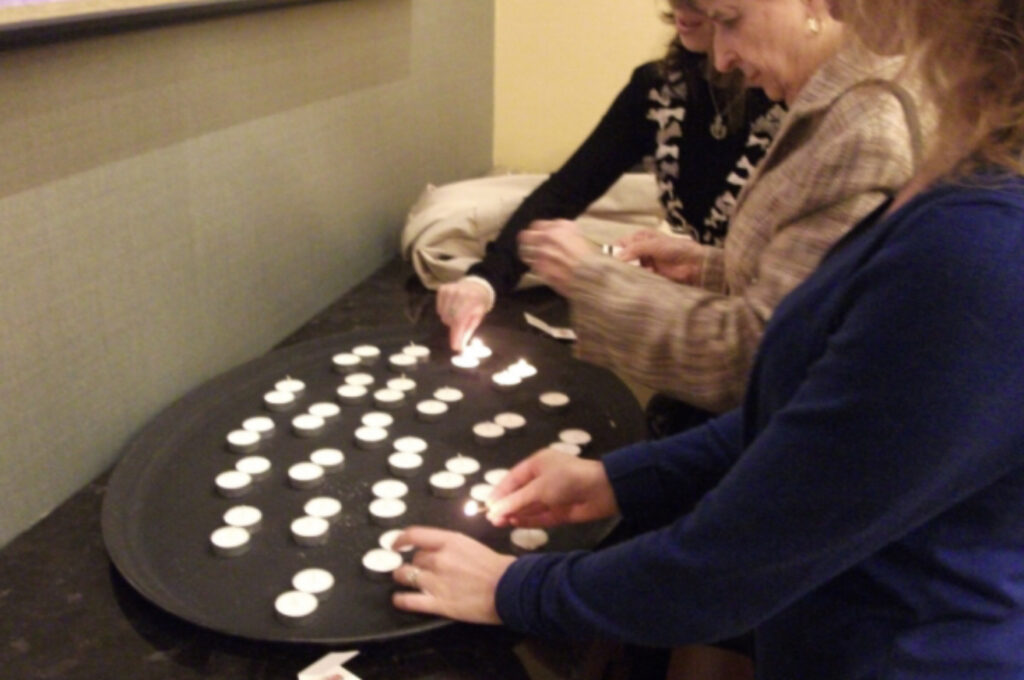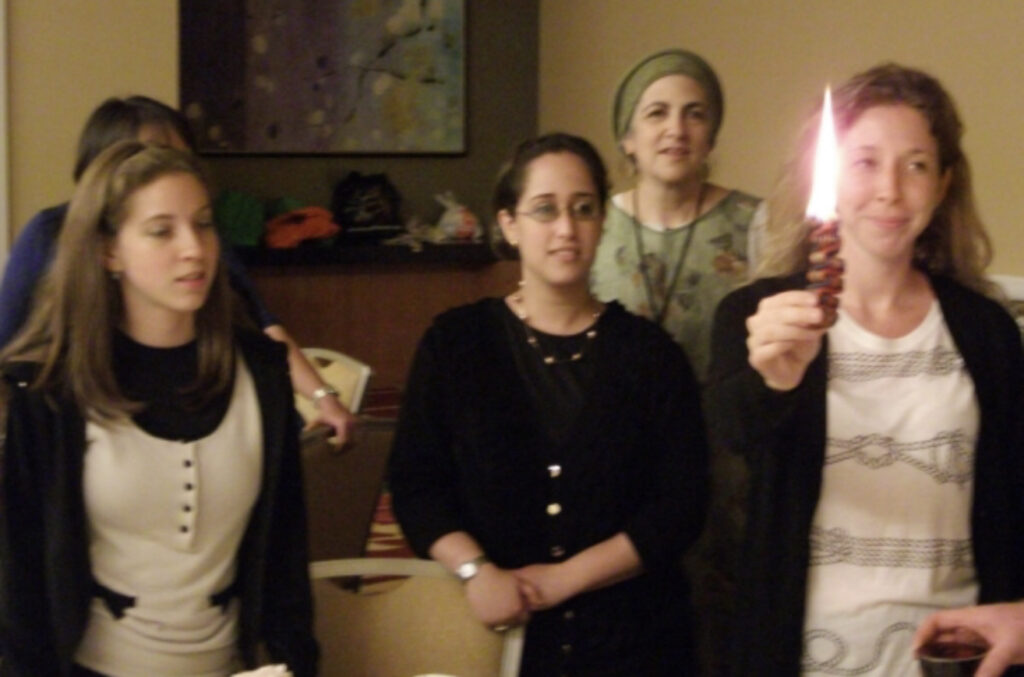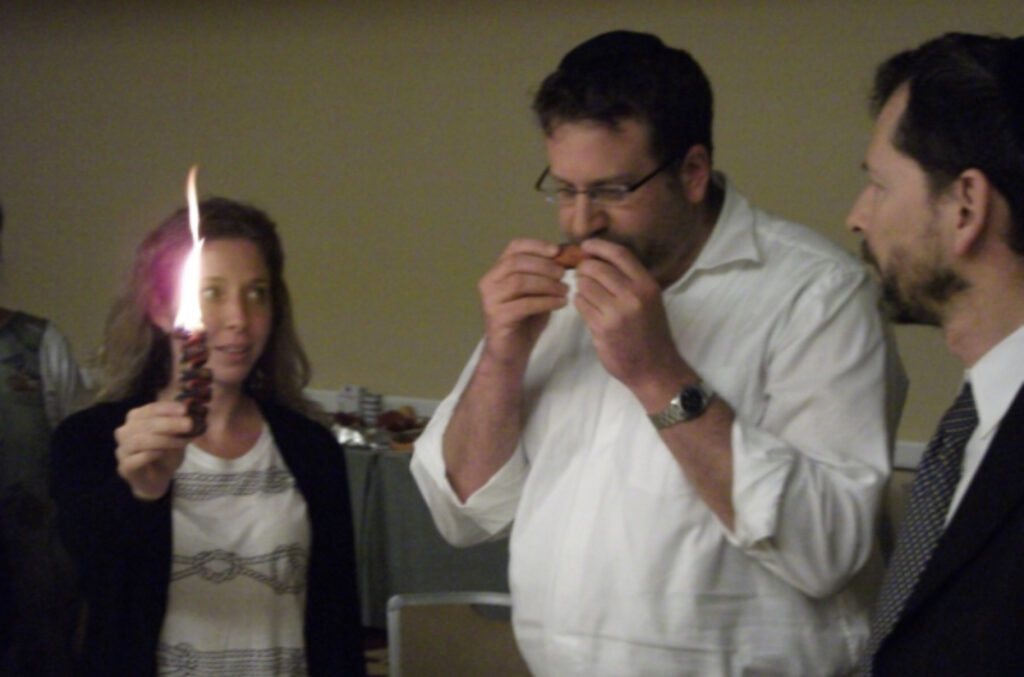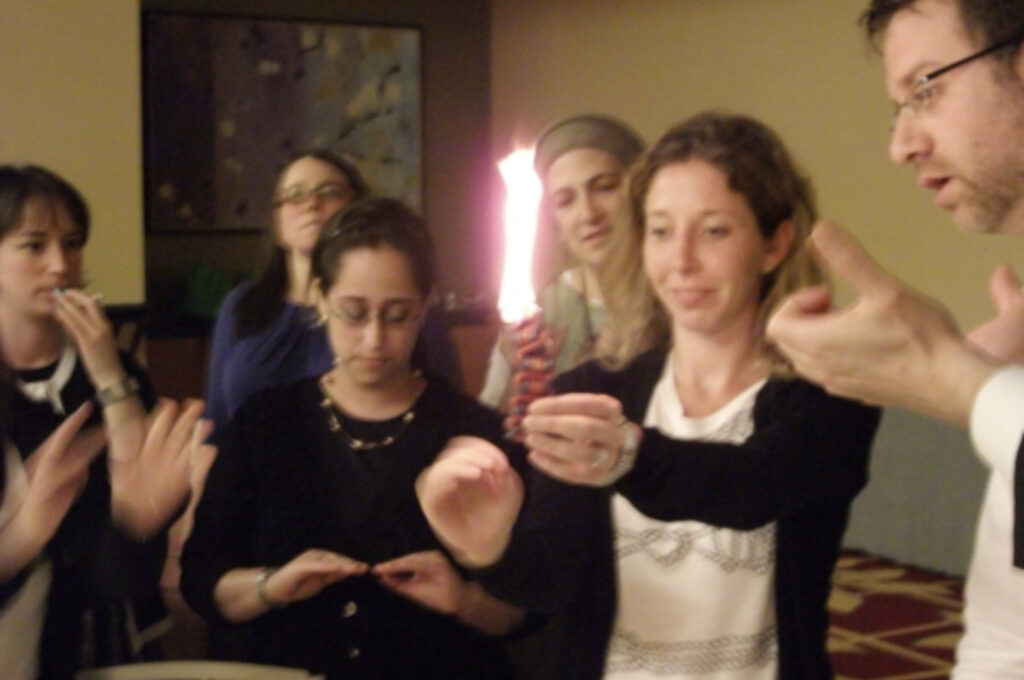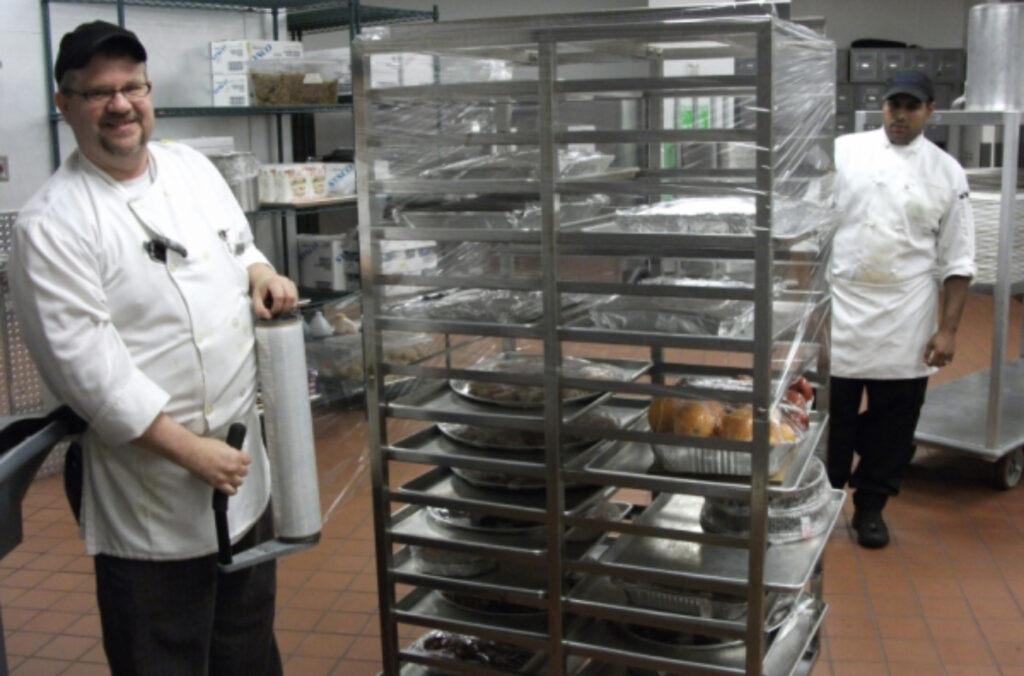Archives
Our Past Shabbat Programs
AOTA Conference 2019 – New Orleans, LA
April 4-7, 2019
New Orleans Ernest N. Morial Convention Center
Menu
Shabbat Menu
Friday night Dinner
Kiddush
Moroccan Fish
Mediterranean Salad
Honey Lime Chicken
Moroccan Rice
Yershualmi Kugel
Brownies
Fruit Platter
Soda, Water, Seltzer
Shabbat Lunch
Kiddush
Tuna Salad
Deli Platters
Mango Salad
Red Cabbage Salad
Hummus
Pita
Chocolate Chip Cookies
Fruit Platter
Soda, Water, Seltzer
————————————–
Meals from the Casablanca Restaurant
3030 Severn Ave, Metairie, LA 70002
Kashruth under the supervision of the
Louisiana Kashruth Committee
http://www.louisianakosher.com/
AOTA Conference 2018 – Salt Lake City, UT
- Shabbat Meals took place at the Convention Center, not at one of the hotels as in the past.
- Shabbat after Shalosh Seudot was “bring your own and share”. The room at the Convention Center was ours from Candle Lighting Friday until after Havdallah Saturday.
Menu
Shabbat Menu
Friday Night Dinner
Homemade Dips w/Pita Chips
Hummus
Tehini
Spicy Matbucha
Chefs Salad with Sweet Creamy Dressing or
Spring Salad with Tomatoes, Cucumbers, Red Onion w/Honey Dijon Dressing
Asian Green Salad w/Sesame Ginger Dressing or Asian Cabbage Salad w/Mandarin Oranges and Craisins
Ratatouille
BBQ Chicken or
Chicken with a White Wine Sauce or Tofu
Dessert
Fruit Platters or Assorted Cookies and Brownies
Shabbat Lunch
Homemade Dips w/Pita Chips
Smokey Baba Ganoush
Spicy Matbucha
Asian Green Salad w/Sesame Ginger Dressing
Asian Cabbage Salad w/Mandarin Oranges and Craisins
Dijon Crusted Salmon
Deli Platters
Challah Rolls
Ketchup
Mustard
Mayo
Potato Kugel
Cold Sesame Noodles
Quinoa Salad
Assorted Roasted Vegetable Platters
Dessert
Assorted Cookies and Brownies
————————–
Our Shabbat dinner and lunch were catered by Kosher On the Go
1575 South 1100 East
Salt Lake City, UT
(801) 463-1786 (801) 755-6194
(under the supervision of Chabad of Utah)
AOTA Conference 2017 & Centennial Celebration – Philadelphia, PA

Gallery
AOTA Conference 2016 – Chicago, IL

AOTA Conference 2015 – Nashville, TN

Gallery
AOTA Conference 2014 – Baltimore, MD

“Shabbat in Baltimore – An Experience to Remember”
Shabbat In Baltimore — An Experience to Remember
From the stirring sounds of L’Chah Dodi that echoed through the banquet room Friday evening, to the quiet sniffing of the Be’samim in the darkened room 25 hours later, the OJOTC Shabbaton during the 2014 AOTA Conference and Expo was an experience to be remembered.
We had a record number of participants in this Shabbat, with more than 55 OT’s, OT students and several spouses filling the Ruth Room of the Hilton Baltimore which was provided for us by AOTA.
The meals were plentiful, scrumptious and filling, the conversation was friendly and uplifting, and the atmosphere turned this Shabbat into something very special.
And for the first time in the 9 years that OJOTC has hosted a Shabbat program in conjunction with the AOTA Conference, we had a Minyan for Friday night, Shabbat morning as well as Shabbat afternoon Minchah-Ma’ariv.
We had 12 men of our own for Minyanim, plus Rabbi Levi Druk of Chabad of Downtown Baltimore and one of his friends, a local Cardiologist who was so jealous that his profession could not emulate our Shabbat program at its conferences. Rabbi Druk loaned us the Sefer Torah we read from on Shabbat, inspired us with a D’var Torah before Musaf and also joined us in the afternoon for Shalosh Seudot.
This was also the first time that we added our own Shabbat afternoon sessions combining OT practice and issues of relevance to Observant Jewish OT’s and OT students. The two sessions turned into times of spirited discussion and exchange of experiences and ideas.
Barbara Kornblau, JD, OTR/L, FAOTA, a Past President of AOTA, who also has a law degree, led a session on dealing with religious discrimination in OT education and practice. She shared her own experiences in fighting religious bias and offered concrete ideas for how to handle situations which may involve discrimination.
Several of the OT’s and OT students also spoke about situations that they had encountered in college or in the workplace.
Rivka Molinsky, PhD, OTR/L Program Director of the OTA program at Touro College, led a “round table discussion” about experiences in college and the workplace.
Both sessions were spirited, well-attended and provided an alternative to other goings on at the Convention Center Shabbat afternoon.
Shabbat dinner and lunch came from the well-known Dougie’s Restaurant. The meals included Gefilte Fish, salads, grilled and fried chicken cutlets, potato and noodle kugels, and deli, plus scrumptious chocolate chip cookies, watermelon and cantaloupe. Shalosh Seudot came from Seven-Mile Market in Baltimore, and featured six different varieties of salads, a variety of fresh fruit chunks and a mouthwatering assortment of cookies, Danish and pastries.
When we all gathered around for Havdalah, there seemed to be the same thought on so many people’s mind – what can we do to top this next year in Nashville?
Gallery
Quotes
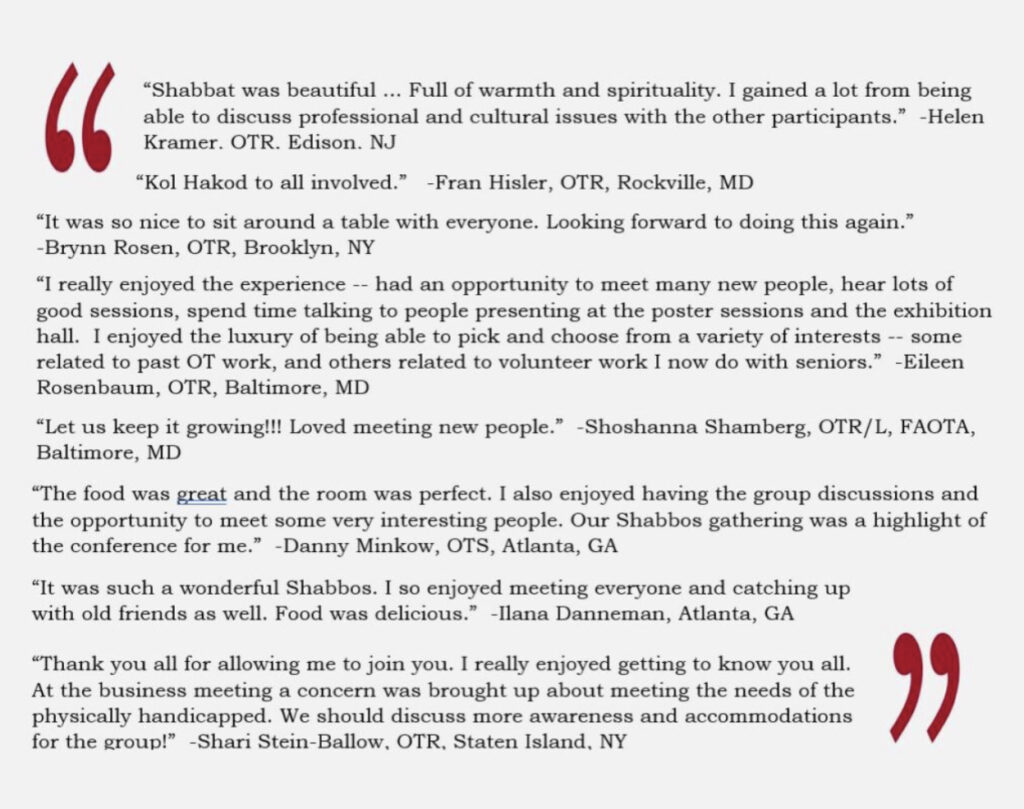
AOTA Conference 2013 – San Diego, CA

Gallery
AOTA Conference 2012 – Indianapolis, IN

Gallery
OJOTC in the News
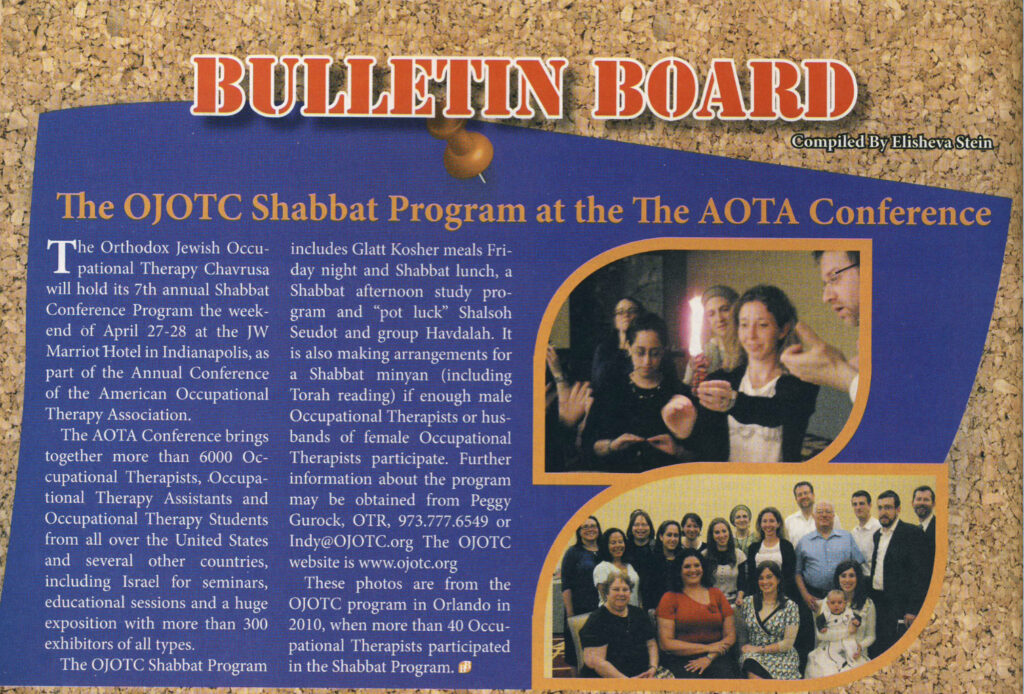
AOTA Conference 2011 – Philadelphia, PA

“A Family Affair in Philadelphia”
A Family Affair in Philadelphia
The OJOTC Shabbat during AOTA’s Annual Conference in Philadelphia turned into a wonderful family affair.
Our Shabbat program was held in the Marriott Philadelphia, as part of the AOTA Multi-Cultural Diversity and Inclusion Network’s annual meeting program.
In past years, a couple of spouses had joined their OT partners for our Shabbat meals. But this year, there were more.
Former AOTA President Barbara Kornblau not only was joined by her husband Larry Sherry who has been an annual guest at our Shabbat, but also by two of their older children.
And Shoshana Shamberg not only brought her husband, but only three of their children for our meals. In fact, their son Lev helped us end the Shabbat with a beautiful Havdalah in our banquet room of the Philadelphia Marriott, while their daughter Sivia held the candle. Shoshana’s parents also joined her for Shalosh Seudot.
It was a very special Conference for Shoshana. She was among those honored by induction into the AOTA Roster of Fellows, and her family joined the rest of her friends and colleagues in celebration her honor. Shoshana was recognized as an “Advocator, Networker, and Educator for Accessible Solutions”.
This year’s Shabbat program was also notable for where those attending came from. In addition to OJOTC members from New York, New Jersey and Maryland, there were OT’s from Israel, from Washington State and from Nebraska. And several of those who joined us found out about our Shabbat program from flyers posted at conference. They were warmly welcomed by those who had planned to spend Shabbat meals together.
We even had a New Yorker who was attending a nursing conference in Philadelphia who heard about our Shabbat program and joined us.
Speaking of the meals, they were scrumptious and the food was plentiful. Catered by the Cherry Grill of Cherry Hill, New Jersey (just across the river from Philadelphia). Salad, Gefilte Fish, chicken with sides with fruit and brownies for dessert Friday night. Salad, deli, chicken cutlets, sides with fruit and cookies for dessert (in addition to plenty of leftovers from Friday night) for Shabbat lunch.
Shalosh Seudot was a combined of leftovers and a variety of items that we all brought to share.
All in all, it was a wonderful way to spend Shabbat together – even if it was just a day before Pesach.
Next year – Indianapolis – two weeks AFTER Pesach. Pesach ends April 14, 2012 — Conference begins April 26.
Mark your calendars now.
Gallery
AOTA Conference 2010 – Orlando, FL

Gallery
AOTA Conference 2009 – Houston, TX

“Yes, we made history in Houston”
Our Shabbat program at the AOTA Annual Conference was the most successful yet. Despite a pouring rain storm which erupted just before candle-lighting time and soaked to the skin some people staying at other hotels, our Friday night dinner drew an overflowing group of 35 people, in addition to several other OT’s from Israel who joined us for candle-lighting.

Getting together for Shabbat were OT’s and OTH’s from New York, New Jersey, Maryland, Florida, Ohio, Nebraska, Oklahoma and Israel. We were also joined by Karen Smith, AOTA’s liaison to the Multi-Cultural Network, who told us she was impressed with our gathering and our members’ commitment to AOTA.

Dinner was scrumptious. Fresh garden salad. Chicken with string beans, potatoes and rice. Fresh fruit.Plus z’mirot, and divrei Torah. Shabbat morning made history as well. For the second straight year, we had a minyan for Shabbat davening. But this year was Rosh Chodesh. And for the first time, we had two Kohanim and two L’viim. We also had several women davening behind our makeshift Mechitzah.

Lunch was a Shabbat feast. Fresh garden salad, “Schnitzel on a Stick”, deli with the trimmings, Humus, Tabouli and Baba Ganoussh. Plus cookies and fresh fruit for dessert. Our guests for lunch were AOTA Treasurer Saburi Imara and Shep Kshepakaran of the Mutli-Cultural Network But before everyone at lunch scattered for sessions or naps, another first: a decision to gather at 6:30 p.m. for Shalosh Seudot, on the 8th floor of the conference hotel, the Hilton Americas, where we found a lounge area.

Wow, was there plenty of food. Not only were there leftovers from our Shabbat lunch, but it seems everyone staying in the Hilton brought food that they had prepared for their personal Shalosh Seudot. We ate. We chatted. We talked about next year in Orlando. And before we knew it, it was time for Havdalah.

Havdalah was outside the Hilton in a corner by the driveway which was protected from the wind. At least it had been protected from the wind earlier in the day, and on Friday and on Thursday. But when we gathered, the wind was blowing right at us. Nevertheless, we were able to shield the wind, light our candle and join together for Havdalah and Counting of the Omer. And still more history was made by OJOTC in Houston. Two of our members were honored with major awards presented by AOTA at its annual awards ceremonies…

Barbara Kornblau, JD, OTR/L, FAOTA, a former AOTA President, of Miami, Florida, who along with her OTH, Larry Sherry, has been with us from the beginning, was honored with AOTA’s “Award of Merit” for “Leading, Mentoring, Inspiring the Profession’s Future” Marian Arbesman, Ph,D, OTR/L of Williamsville, New York, was honored with the “Cordelia Myers Writer’s Award” for her article “Evidence-Based Perspective on the Effect of Automobile-Related Modifications on the Driving Ability, Performance and Safety of Older Adults”, published in the March/April issue of the American Journal of Occupational Therapy”


As has become a regular event at AOTA Conference, many OJOTC members were among those presenting during the 4-day event. They included: Barbara Kornblau, JD, OTR/L, FAOTA; Marian Arbesman, PhD, OTR/L; Penina Weiss, MSc, OTR of Tel Aviv University; Jennifer Tamar Fromm-Kalina, MS, OTR/L, of NYUHJD MS Care Center; Peggy L. Gurock, OTR of Trinitas Children’s Therapy Services and Rivka Molinsky, OTR/L of Touro College; Joyce Sabari, PhD, OTR, FAOTA along with her students at SUNY Downstate Medical Center; and Yaffa Youseflaleh, OTS of Long Island University.

Our congratulations to all the honorees and presenters, and a reminder that proposals for presentations at next year’s conference in Orlando (April 29 to May 2, 2010).

AOTA Conference 2008 – Long Beach, CA

“We did it!”
We did it!
For the first time, there was a Shabbat Minyan, including K’riat HaTorah, at the annual AOTA Conference, as part of our OJOTC Shabbat program.
But it wasn’t easy.
With a couple of men who had planned to be at Conference cancelling, we had to find a couple of others at the last moment. And we did, thanks to former AOTA President Barbara Kornblau and her husband, Larry Sherry, who roamed the Expo Hall Thursday evening and Friday afternoon, using that famous question: “Are you Jewish?”. They found a couple of men who agreed to join us Shabbat morning; OJOTC founder Peggy Gurock and her husband found a couple of others.
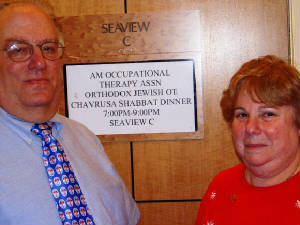
Then we held our breath Shabbat morning to see how many would actually show up.
Enough did by the time for K’riat HaTorah, to make the minyan.
The Sefer Torah was loaned to us by the Long Beach Chabad; the Siddurim along with photocopies of the Parsha and extra Taleisim came from the Young Israel of Passaic-Clifton, New Jersey.
The Torah was read by Paul Stadtler of Staten Island, New York, Yehudah Malka of Baltimore, Maryland and Noah Gurock of Passaic, New Jersey.
To say it was spiritually uplifting was an understatement.
It was historic.
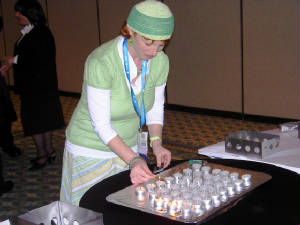
For those of us who had been talking for three years about being able to have a minyan during Conference it was more than gratifying – it was a sign that efforts to attract frum OT’s to Conference are paying off.
But the minyan – held in the Harbor Room of the Hyatt Regency Hotel — was only part of our Shabbat program.
Shabbat began with candle-lighting and dinner in the Hyatt’s Seaview Room. The room provided for us by AOTA, and the buffet dinner delivered from Los Angeles by the world-renown Pico Kosher Deli.
More than 25 OT’s and their guests gathered for dinner around the tables set with Shabbat flowers. They came from California, Arizona, Massachusetts, Maryland, Florida and Israel.
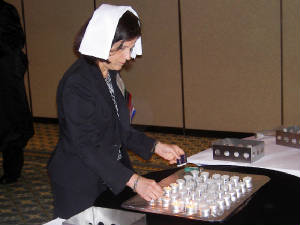
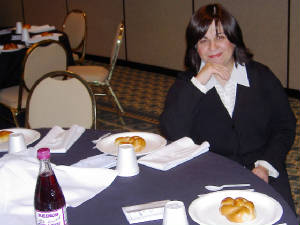
We were also honored by the presence of not only former AOTA President Barbara Kornblau and her husband, but also by another former AOTA President, Karen Jacobs, current AOTA Vice President Florence Clark, AOTA Public Advisor Arthur G. Isack and AOTA’s Multi-Cultural Liaison Laurel Radley.
On the menu: lemon chicken, with potato kugel and green beans, salads and fruit.For three hours, we ate, drank, sang Z’mirot from our special OJOTC benchers, listened to a Dvar Torah from Chezkie Rand, and simply schmoozed.
After the “minyan room” was changed into our dining room, we gathered for lunch. Salad, cold cuts, grilled chicken, trimmings, fruit and scrumptious chocolate chip cookies (with plenty left over for Shalosh Seudot in our rooms).
After plenty of time for session, napping and strolling, it was time for Havdallah, held in the warm Long Beach air on the patio between the Convention Center and the Hyatt. With a truly overflowing cup of grape juice and spirits that were overflowing with emotion, we ended our Shabbat program with a promise to make next year’s in Houston even more meaningful with even more OT’s and their guests.
Karen Jacobs later e-mailed us that joining OJOTC for Shabbat dinner, was the highlight of her conference experience.
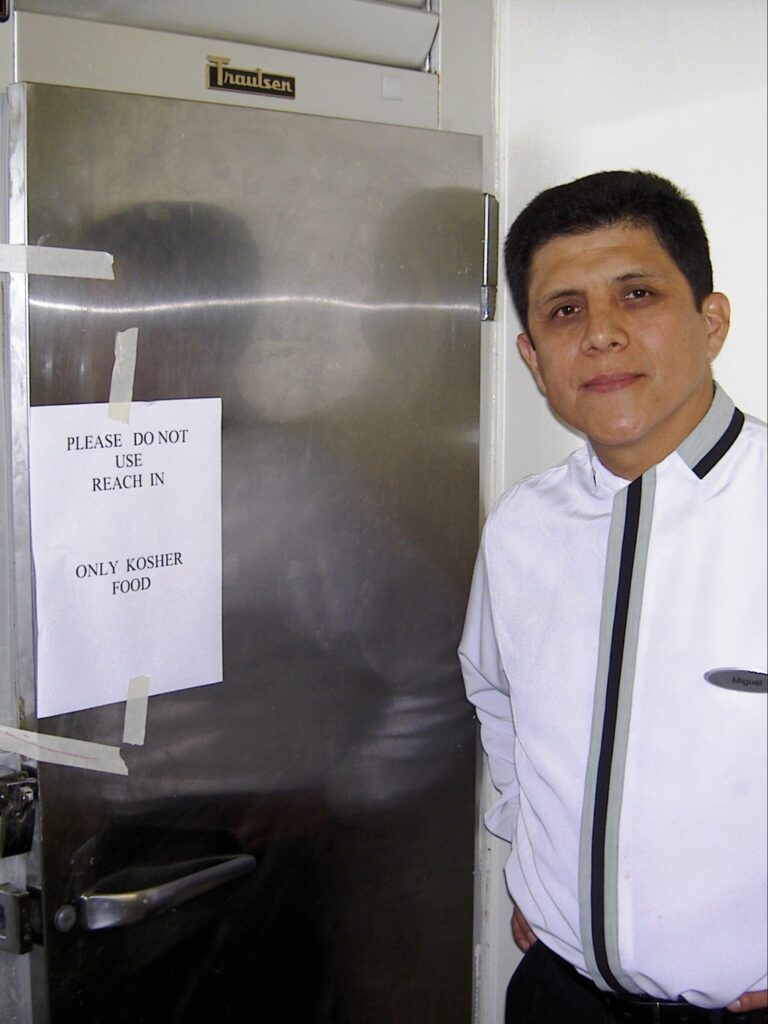
Many thanks go to everyone who participated in this OJOTC Shabbat Program and to AOTA for understanding our needs to combine our religious observance with our desire to broaden our OT knowledge.
In addition to providing us with the rooms for our meals and our minyan, AOTA staff made arrangements for us to leave out conference bags and material in the Convention Center over Shabbat (since there is not Eruv in the area) and helped us create a system to make sure we got our continuing ed credits without having to hae our electronic badges swiped on Shabbat.
Thanks also to the staff of the Hyatt Regency for understanding our Kosher food needs and working with us to make sure they were met, as well as taking OJOTC members to their rooms and opening the electronic door locks on shabbat without having it explained to them.
Now, on to Houston for AOTA’s 89th Annual Conference, April 23-26, 2009
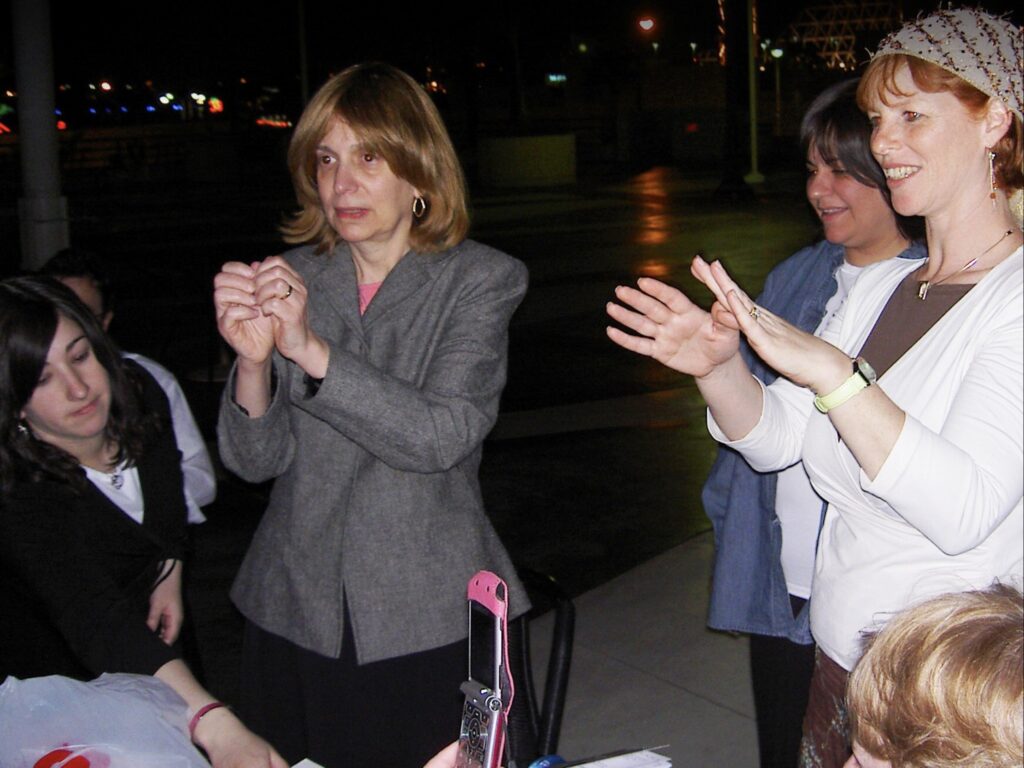
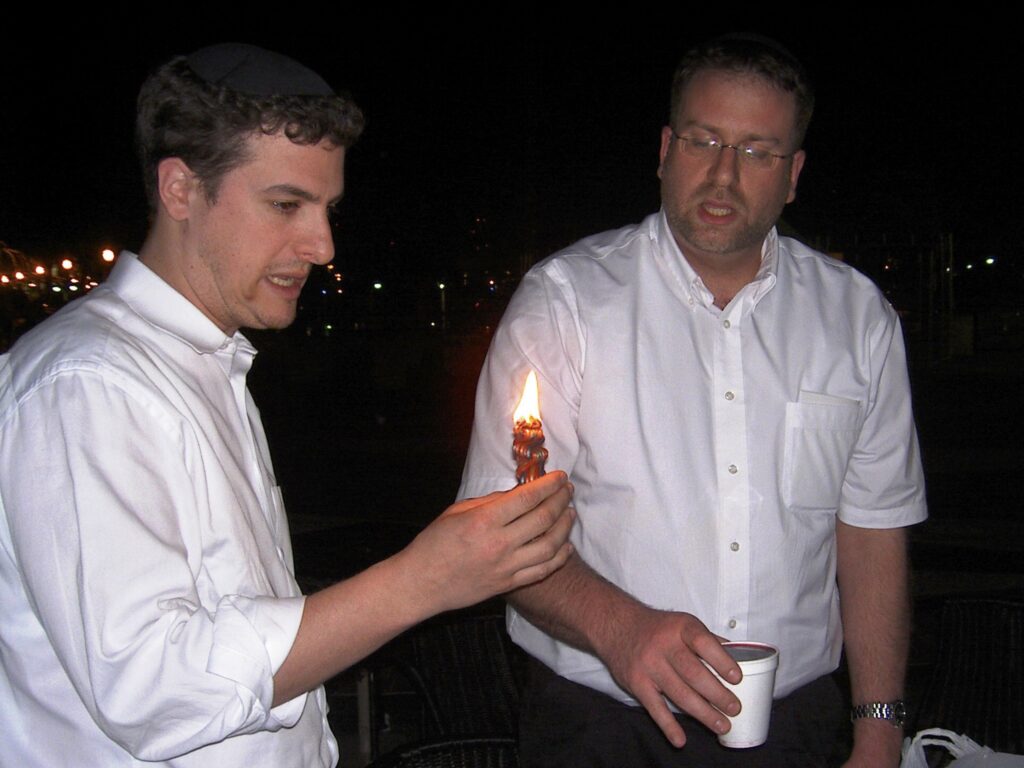
Presentations by OJOTC Members
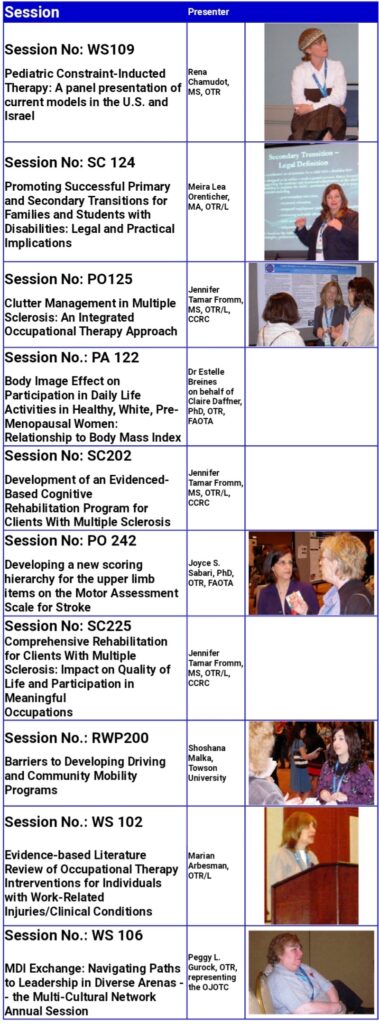
AOTA Conference 2007 – St. Louis, MO

“The St. Louis Shabbat Experience”
The St. Louis Shabbat Experience
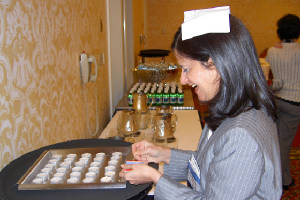
Shabbat candles were six rows of tea lights, kindled on a square tray in the corner of a hotel meeting room. Havdalah was on the pavement, under the hotel’s covered ballroom entryway. In between were 25 hours which combined the spiritualism and sanctity of Shabbat with the camaraderie and friendship of colleagues, and professional growth in a relaxing manner that only Shabbat can bring. This was what the 2nd Annual Shabbat Program of the OJOTC brought to St. Louis, April 20 to 23, as part of the 87th Annual Conference of the American Occupational Therapy Association.
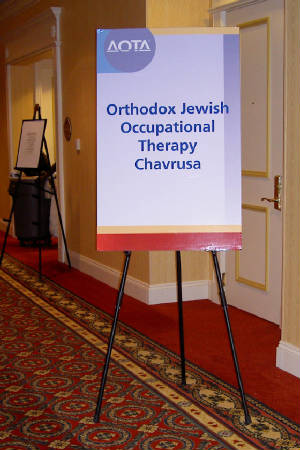
When we arrived in St Louis the day before Conference began, OJOTC had 16 confirmed reservations for our Shabbat dinner; and 10 for Shabbat lunch.
Then, we posted flyers on conference center bulletin boards — and our cell phones started ringing.
By the time Chezkie Rand began Kiddush, we had three tables full, two dozen women and men, seated in the Renaissance Grand Hotel’s meeting room turned into a room full of Shabbat sounds and aromas.
Flowers were on the table, and a scrumptious buffet prepared by a local Glatt Kosher caterer was spread out on serving tables. Shabbat candles were on another table. And washing stations set up by the hotel were in another corner of the room.
Around the tables were OT’s and their guests from New York, New Jersey, Pennsylvania, Maryland, Massachusetts, Florida, Ohio and Cleveland, as well as two OT’s from Israel.
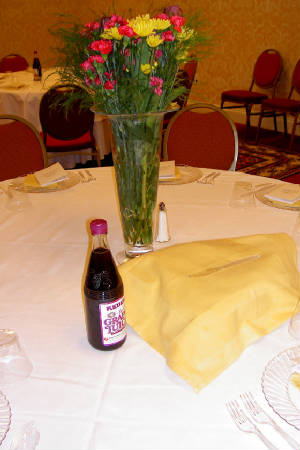
We were also honored to be joined by Laurel Radley, Associate Director of Professional Affairs for AOTA, and Barbara Kornblau, Past President of AOTA along with her husband.
We ate, we drank, we schmoozed, we sang Z’mirot from our own specially-prepared OJOTC Benchers, we heard Divrei Torah and we realized once again the value of meeting new friends and re-connecting with others, especially around a Shabbat table.
Shabbat lunch was more of the same, with a couple of new faces around our table.
What a pleasure it was to share full Shabbat meals with each other, Kiddush, appetizers, salads, chicken, cold cuts, desserts and more, instead of opening packages in our individual hotel rooms. To say nothing about being able to “bench” together and to truly feel the spirit of Shabbat as a group.
And then there was Havdalah.
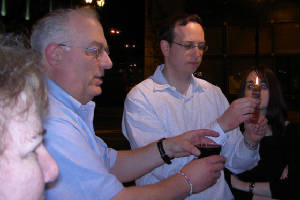
Last year in Charlotte, we had to fight the winds blowing by the hotel’s entrance and retreat to the entrance to the hotel’s garage.
This year, we gathered on the sidewalk, under the entrance to the hotel’s ballroom building. And we had no trouble keeping the candle lit.
Next year, when we return to the sandy shore of Long Beach, California (where OJOTC got its start), who knows where Havdalah will be celebrated.
One thing is certain, Shabbat at Conference will once again be a unique experience for all of us.
And next year, we expect to have a Minyan to add to our Shabbat experience.


Presentations by OJOTC Members

AOTA Conference 2006 – Charlotte, NC

“The Shabbat Experience in Charlotte”
The Shabbat Experience in Charlotte
What a difference a year makes!
Last year, we were ten, sitting around a hotel board room table in Long Beach, California, sharing a “pot luck-style” dinner on Shabbat, that was put together at the last minute.
This year, were were 20, enjoying a catered Shabbat dinner in Charlotte, North Carolina, where we were gathered in a private dining room at the Hilton Hotel, during this year’s AOTA Annual Conference and Expo.
And what a wonderful Shabbat it was.
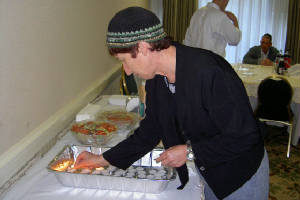
Last year, we were forced to light Shabbat candles by the pool, where the candles barely stayed lit long enough for the women to say the B’rachot, before the wind blew them out.
This year, Shabbat candles were lit in our dining room, and they remained lit through our entire meal.
Last year, the words for the Z’mirot we sang together came from our collective memories.
This year, they came from our own specially-made OJOTC benchers which everyone was able to take home after Shabbat as a souvenir of this Shabbat Experience.
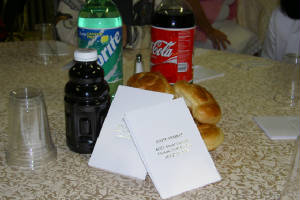
From Kiddush in our dining room to Havdalah in the Hilton lobby, this was truly a Shabbat experience to remember and to build upon for the future.
Thanks to the graciousness of AOTA and the staff of the Charlotte Center City Hilton, we sat down and truly enjoyed our Shabbat together, not just for dinner, but for Shabbat lunch as well.
AOTA provided us with the room, with its own placard outside, and the Hilton allowed our caterer, Jeff Gleiberman of Charlotte’s only Glatt Kosher restaurant and grocery, to bring in our meals, giving us the run of their kitchen and special refrigerator space to store our lunch items overnight.
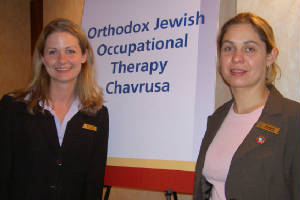
Dinner came in just out of the oven, having been cooked at the Charlotte Chabad Center Friday afternoon, and delivered to us just in time for Candle Lighting.
And what a dinner it was:
Mouth-watering Gefilte Fish, fresh salads, herb-baked chicken, roast potatoes, green beans and luscious pastries for dessert.
We ate, we talked, we sang Z’mirot, we listened to a Dvar Torah from Paul Stadler of Staten Island and by the time benching came around, we were exhausted from a day at the Conference and an evening of Shabbat togetherness.
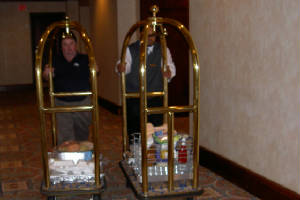
We came from various parts of New York and New Jersey, as well as Georgia, Florida, Israel and yes, our host state of North Carolina.
Not only were we pleased to have AOTA’s immediate Past President Barbara Kornblau and her husband with us, but we were also joined by AOTA Federal Affairs Reprsentative Leslie Jackson, who stopped by to make sure everything was running well and stayed to enjoy dinner with us. (Leslie was the one who had worked with OJOTC through the past 12 months to help us make the arrangements for this Shabbat).
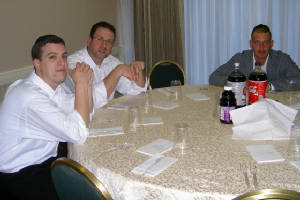
We also counted among us the “youngest OT” (or “OT to be”), 18 month old Malka, daughter of Rivka Molinsky of Far Rockaway.
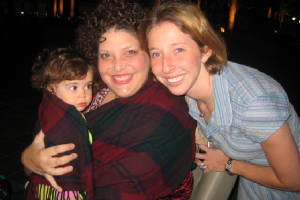
Shabbat lunch included plenty of salads, deli sandwiches and plenty of chicken and potatoes that hadn’t been finished at dinner. Joining us for lunch was Liz Lannigan, Treasurer of the NJ OT Association, who has worked with us to make sure that Glatt Kosher meals are available at the annual NJOTA Conference.
There was even food for those who were staying at the Hilton to take to their rooms for Shalosh Seudot.
The only item not planned was where we would gather for Havdalah.We decided on the plaza outside the Hilton.
But the wind prevented our candle from staying it.
So we moved inside, to a corner of the lobby, and there we ended our Shabbat experience.
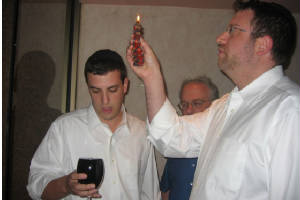
Shabbat was not the only day during the conference when eating a real Glatt Kosher meal was not an issue.
AOTA was able to arrange for us to enjoy a full box dinner on the first evening of the Conference, during the first session at the Expo Hall. This came from Neshama Kosher Catering (Rabbi Mordechai Roizman).
We were told that more than two dozen meals were ordered just for the Expo Hall dinner.
In addition, Kosher meals were provided for other Conference events, quite a difference from a couple of years ago, when only two OT’s asked for Kosher meals during Conference.
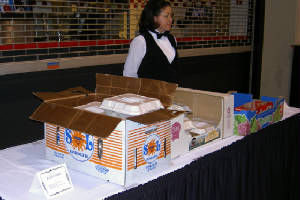
What’s next?
St. Louis, April 20-23, 2007, where we hope to once again double the number of OT joining us for Shabbat meals.
And for next year, we are already discussing how we can expand our Shabbat program, to make the Shabbat Experience at Conference an even more inspiring one. First on our agenda, a Shabbat morning minyan, with Torah reading.
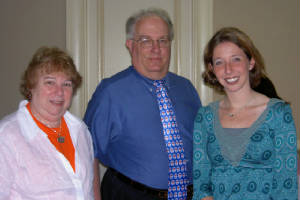
If you have any ideas, e-mail them to [email protected]
L’Hit-ra-ot!
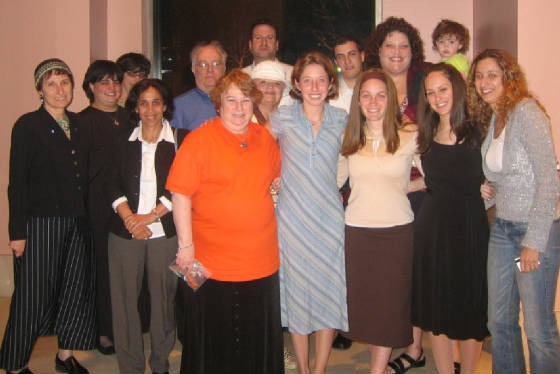
Poster Presentation at Conference
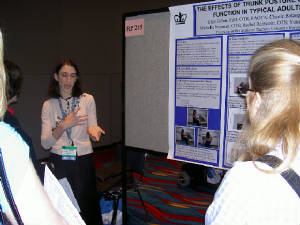
Rachel Rothstein of Columbia University, explains her research project on “The Effects of Trunk Posture on Arm Function in Typical Adults” to other OT’s and OT students during Friday morning poster session at the AOTA Conference in Charlotte.
Other OJOTC members participating in this research project were Ariella Neuman and Yona Schaap, also of Columbia University.
Congratulations to all of them!
Back to top^
Past Newsletters
Back to top^
News from Our Members
“OT Travels to India Bringing Training and Receiving Connections” (2010)
“OT Travels to India Bringing Training and Receiving Connections”
By Shoshana Shamberg, OTR/L, Ms
President of Abilities OT Services and Seminars, Inc.www. AOTSS.com / [email protected]
Baltimore, MD
Internet teaching brought me to an enlightening, inspiring, and exotic on-site teaching experience in Mumbai, India in January of 2010. One year ago, Dr. Vandita Gupta, an OT living in Mumbai, India emailed Abilities OT Services and Seminars, Inc. (AOTSS), requesting internet training on sensory motor strategies for continuing education to increase her professional skills. Vandita’s private practice focuses on children with sensory processing disorders including ADD/ADHD, SI issues, reading and writing problems, and autism. Obtaining training for OTs is difficult in India and often traveling for CE is the norm. As a mother of two young children, she did not want to travel; preferring internet learning which she could do at home at less expense.
At the time, AOTSS trainings focusing on Sensory Motor Interventions and Strategies consisted of only onsite, 2-Day seminars. The learning in this training includes Brain Gym, Irlen Method, kinesthetic handwriting, vision training exercises, multiple intelligences, Bal-A-VisX and low-cost assistive technology with additional mentoring via the internet after the seminar. Vandita insisted on a similar training via the internet and was willing to pay for personal mentoring which would include. She paid me to develop a personalized mentoring program that would include all topics in the 2-Day seminar. This began a one year relationship and learning experience which blossomed into the Sensory Motor Strategies on a Shoestring Budget Internet Training and Mentoring Program.
I sent her training manuals and a box of materials, which a relative traveling from the USA to India brought to her, eliminating the high cost of international postage and handling. From these materials, along with recycled and low cost items she could find in India, Vandita created treatment materials of excellent quality and creativity, as well as, learned and used the methods of intervention. She received specific lessons via email with ongoing instruction and guidance, and excelled in using the skills learned, quickly observing positive results with her clients. To document her work, she sent me original treatment plans and pictures of her creations via email, documenting how these were used in her practice and the benefits. Vandita’s ability to translate emailed lessons and instruction into practical, creative, and effective strategies for her clients was inspiring to me, her mentor. New options for client treatment became so successful that she requested I come to teach others in Mumbai, India.
Negotiations and preparation for the trip from the USA to India took 5 months of planning seminar details and marketing to local professionals and parents to obtain enough participants to make the trip financially feasible. Judging from the excellent post seminar evaluations from 27 highly trained professionals who participated, the relationship is evolving into an ongoing one, with another multi-disciplinary training in the planning for next year. Participants came from many different cultural and religious backgrounds, experience levels, special and regular education settings, private practice, and disciplines (OT, SLP, psychology, business management, educators, administration and parents of children with special needs.
Prior to the seminar in Mumbai, I traveled to southern India’s Kerala region to participant in therapeutic yoga training at an ashram, spiritual Hindu center, with over 400 people from over 30 countries. I learned the health benefits of breathing in a special way, as well as, the use of Yoga exercises for muscle strengthening, range of motion, stretching of muscles and joints for release of tension and limitation, and relaxation techniques for stress management for the mind and body. I learned interesting massage techniques from highly trained auervetic medicine massage therapists and doctors. I traveled through many low-income villages and communities traveling to and from the ashram, where people live in small shacks, with few modern conveniences like running water and electricity, and one dollar can feed a family for a day. I saw infants, children and adults with horrible deformities and major disabilities begging for money on the streets, living where accessibility and independence is not feasible due to many social, economic and environmental barriers including ancient stone and concrete architecture, narrow dirt roads with no room for pedestrian movement or widening, and extreme poverty I never witnessed in the USA, even during my 25 years working in inner city ghettos.
The good news is that awareness of educating special needs children and employing adults with disabilities is growing, as India becomes increasingly more affluent and educational opportunities expand, especially with the help of dedicated and highly trained OTs in India. Some of them received work experience in the USA after their schooling in India, and returned to work in India, bringing a fearless public awareness about OT, civil rights for people with disabilities, and the benefits to society of rehabilitation and independent living support systems. They are spreading the word about the need for trained professional and community supports and cost effective accommodations in work, home, school and community settings. I met OTs involved in advocacy for OT services telling me their success in the last few years in obtaining media attention. Special education is not mandated by the government, as regular education is, so this must be raised from private sources in order to happen.
While in Mumbai, I was hosted royally and housed by Vandita’s family and the family of her husband, Vitkas, in two very different sections of Mumbai. One lives a mixed area of middle and low income Muslim, Christian, and Hindu cultures and the other mostly upper Middle Class Hindus. In this affluent neighborhood I witnessed cows walking the street freely as sacred animals rarely killed for food, but used for their milk and dairy products. The Indian food cooked in restaurants and homes was exceptional and vegetarian, making it very easy to be kosher during my entire trip. In fact I found it very easy to be Jewish in place where there were no Jewish people since spirituality and respect for those of other faiths is part of Hindu society and religion. I discovered the existence of an ancient Indian Jewish community in Mumbai, called the Benai Israel, but the location was too far to walk to synagogue. Due to two community weddings there was no place for me to stay within the community but another other Shabbat I would have gladly been hosted by strangers in the Jewish community. At Vandita’s parent’s home, I was able to have a peaceful Shabbat with ongoing attention and support for my special needs as an observant Jew. Generosity, compassion and a universal spirituality and respect were major qualities of Vandita’s family and their hosting of me for over a week. We shared our religions, cultures, family, professional insights and experiences with each other, her network of friends and therapists/educators, and her family of 3 generations, which included her 10 and 13 year old children. Of course I went sightseeing, both into the magnificent Mumbai city center with museums, ornate architecture and gardens, the harbor and beach and the site of the Mumbai terrorist attacks which killed many Americans. Traffic jams and crazy drivers of cars, buses, trucks, taxis, and motorcycles was frightening to my western experience living in the much smaller and less congested city of Baltimore, MD. In India it is common to see a mother holding infant, a small child and husband all riding together on a motorcycle without helmets in city traffic or on bumpy, dusty, narrow country dirt roads. Seeing this was quite a shock, especially having worked in physical and cognitive rehabilitation with TBI, spinal cord injuries, etc from vehicle accidents.
Security is very tight which gave me a secure feeling. There is a travel advisory warning from the US customs office for all Americans traveling to India after the December 25, 2009 attempted suicide bombing on an airplane in the USA, as well as, due to the after shock of the Mumbai Massacres last year. I prayed at the sites of those terrorist attacks in hopes of helping to continue the healing for all families affected by the tragedy and visited a memorial inside the Taj Hotel made of a wall of falling water with the names of the victims. Indians are still shocked and feeling the tragedy which shook the world for 4 days as Arab terrorists tortured and killed innocent people, especially foreigners and Jewish people.
My OT host for my last day in India, Mugda, lived in the USA for 8 years as a traveling therapist and returned to Mumbai, her ancestral home and family, where she married and began a multidisciplinary therapy practice. She owns the building housing the clinic and hires a speech therapist, physical therapist, and psychologist to work as a team with special needs children and their parents and medical/educational support systems.
One of the most inspiring events of my trip was a visit to the SPJ Sadnana School, a privately funded special education program for elementary through high school aged students with autism, ADD/ADHD, developmental disabilities, dyslexia, and many other disabilities which prevent them from being included in regular education environments. The students are happy, productive and achieve skills in both academic, life skills and vocational skills that were previous never thought possible by their parents and society. Parents must participate in training and support the educational program in order for their child to participate in the program.
Teachers and therapists are provided ongoing training in innovative and low-cost interventions and learning programs, sending employees oversees when necessary for training if it will help students to learn and function better. Mentoring and support are ongoing for professionals, students and parents. The administrators are role models, demonstrating selfless and unconditional love, caring, and professionalism rarely found elsewhere in the world. In my 35 year career in education, I rated this school with the best I have encountered in my travels and job experience in the USA. Student vocational, self care, social, emotional, behavioral and academic skills are carefully evaluated and supported each and every step of their participation at Sadnana School. Sadnana administration paid for over 10 staff members to attend my training. One could see their professionalism demonstrated. Sadnana School’s ability to accept students of all economic backgrounds depends upon private donations. They do not turn away students if the parents cannot pay and many parents join the staff as volunteers and then become employees, encouraged by the administration to obtain professional degrees and training.
Students participate in an half hour of Brain Gym exercises and other physical movements prior to beginning their academic program daily and later in the day as well. They use Brain Gym exercises embedded within their academic program when they began seeing behavioral and academic improvements with these simple neuromuscular and sensory motor exercises. Their vice principal is an Irlen Method screener and Certified Brain Gym Consultant, having to travel to other countries to receive here training
.Please help if you can by sending even a small donation to support their amazing work for children and young adults with disabilities to become productive members of society with the maximum level of independence. All contributions are tax deductible and they are a non profit with all funds utilized for the benefit of students. The Sadnana School’s building is simple yet practical, but the program is built on commitment to quality programming, professionalism, standards, and increasing knowledge, using low cost traditional and innovative techniques requiring minimal equipment such as Brain Gym, Irlen Method, auditory training, sensory integration, therapy, vocational skills training in crafts, office and computer skills, food/hospitality services, textiles/sewing/printing, diamond sorting, and many other vocations. They insure that students who are capable of taking national educational tests get accommodations in order to participate and succeed.
“The Orthodox OT Boom” – The Jewish Week, 2006

The Orthodox OT Boom
January 20, 2006
Tamar Fromm had planned to spend Shabbat in her hotel room. Friday night dinner would entail little more than a peanut butter-and-jelly sandwich. An Orthodox Jew, Fromm, who keeps kosher, brought sandwich ingredients from home in New York to Long Beach, Calif., where she was attending the annual conference of the American Occupational Therapy Association.
By Friday afternoon, however, Fromm, an occupational therapist who treats people with multiple sclerosis, had met several other observant Jews attending the conference in May. Fromm, 25, scrapped her plans for a sandwich dinner, in favor of a makeshift celebration with about ten Shabbat-observant OTs. They lit candles on the hotel pool deck, and then gathered in a conference room for dinner. There was schnitzel from a local kosher restaurant, salad prepared by one conference-goer, and a jar of gefilte fish picked up by another.
The dinner launched Orthodox Jewish Occupational Therapy Chavrusa (www.ojotc.org). The caucus advocates on behalf of observant Jews working in occupational therapy, a field that in the past decade has become increasingly populated by Orthodox women. Though this particular group has long been a presence in the profession, Orthodox women now account for more than a third of students pursuing master’s degrees in OT at several New York-area universities, including Columbia University, State University of New York-Downstate, and Touro College, according to anecdotal evidence.Occupational therapists teach fine motor and independent living skills to children and adults. An OT might show a wheelchair-bound sixth-grader how to maneuver the lunch line in the middle school cafeteria; coach a developmentally delayed adult on workplace-appropriate social skills; or help maximize hand use and teach personal grooming techniques to an elderly stroke victim who has lost the use of her right arm.
Fromm surmises that the flexibility many OT jobs afford accounts in part for its popularity among Orthodox women looking to balance a career with domestic responsibilities.
In recent years, physical and speech therapies, likewise considered to be family-friendly occupations, have also seen an influx of professionals who are Orthodox women.
“Part of my decision to go into OT was about being a woman, and wanting to be around for my children one day, God-willing,” said Fromm, who received her masters degree in the specialty from Columbia University, where she said Orthodox women comprised about a third of her class.
“If you’re a lawyer with a six-figure salary, you can’t leave the office at five o’clock, and you probably can’t leave at seven o’clock. … OT provides a great second income, but not a great primary income. It’s enough not enough to pay yeshiva tuition and raise a family,” she said.
Though six-figure incomes for OTs are not standard — they make an average of $48,000, according to a 2000 AOTA study — anecdotal evidence shows their earnings are on the rise, with some recent graduates commanding starting salaries topping $60,000.
The spike in pay is due to increased demand for OT professionals as the American populace ages, and as more children are being categorized as learning disabled and targeted for out-of-classroom remediation. The New York City Department of Education offers scholarships to pursue OT studies, in exchange for an 18-month commitment to work in public schools, underscoring the shortage of therapists.
Jim Hinojosa, who chairs the Department of Occupational Therapy at New York University, where he estimated that at least 20 percent of OT students are observant Jewish women.
“It’s a female-dominated field that gives people lots of options to work while taking care of a family in a traditional way,” Hinojosa said, noting that an upwards of 90 percent of OTs are women. “I think the [career] choice is related more to gender and family, than it is to Orthodoxy.”
There’s a lot of available part-time OT work, said Estelle Breines, president of the New Jersey Occupational Therapy Association and the former director of the Long Island- and Manhattan-based OT programs at Tuoro College, where she said up to two-thirds of her students were Orthodox Jewish women.
“If someone wanted to take off a year to have a baby or care for an elderly parent, there’s less of a penalty in occupational therapy than there would be in other professions,” Breines said.
She added, “One thing about the Orthodox community is that they communicate a great deal with one another. If someone has figured out that this is a good career for young women, the word is out.”
But the livelihood is attractive to Orthodox women for more than merely
practical considerations like flexible hours and rising salaries.
“The ethical principals that drive Judaism are compatible with the profession,”
Breines said. “Some of the notions of tzedakah are strongly grounded in
enablement, and occupational therapists enable people to participate in this
society.”
One recent graduate of Stern College, who was active in the school’s
Occupational Therapy Club, agreed, adding, “I think the reason a lot of Jewish
girls go into it because they were brought up in homes where chesed was
important and they want to give back to their community and to the general
community.”
The woman, who did not wish to be identified by name, is now pursuing a master’s in occupational therapy.
“Every once in a while, people will say to me, ‘Oh you’re going into OT,’” she
said, mimicking an unimpressed tone. “But it’s much harder than people think.
Maybe at first glance, it just looks like we’re doing basic activities, like
coloring with children, but it really requires a lot of knowledge about the
body, about movement.”
Janet Falk-Kessler, the director of Programs in Occupational Therapy at Columbia University, which offers a joint program with six schools including Yeshiva University’s Stern College for Women, said the career’s popularity among Orthodox women “makes sense.”
“From my understanding of Judaism, and being Jewish myself, I know the
importance of community service and healing professions,” said Falk-Kessler, who said the program attracts a significant Orthodox female contingent, but did not want to guess on numbers.
Other OTs working in academia were weary about speaking about it on record, saying that it could fuel the stereotype that OT is a profession for Orthodox Jewish women and could hurt their efforts to recruit a diverse student body.
Devorah Gerber, a 25-year-old Orthodox occupational therapist from Cedarhurst, L.I., acknowledged that the lifestyle and income OT jobs afford are appealing to “a lot of Orthodox women with large families,” but agreed that these were not reason enough to pursue an OT career.
“I don’t want people to go into this field because they think it’s an easy way
out,” she said, noting that her training included a rigorous two-and-a-half-year
master’s program. “That would be unfortunate in a field where you can have such an impact on children and on families.”
Gerber received her master’s degree at Brooklyn’s SUNY-Downstate, where she guessed that about 40 percent of her classmates were Orthodox women.
Ruth Ann Meyers, who chairs the OT department at Jefferson College of Health Sciences, said she worries that too many people are choosing the profession for the lifestyle it affords.
“Thirty years ago, the first thing women would say is, ‘I want to help people,’”
she said. “Now it’s often, ‘I want a job.’ Occupational therapy can’t be done
just because someone wants a job, just because someone wants money. It requires you to be present emotionally. I think that’s why there are so many Orthodox Jewish women in this profession. The have to juggle a lot of relationships, and can use their insights from these relationships to be good therapists.”
Meyers, who is not Jewish, first noticed the proliferation of Orthodox women in the occupation in the late 1990s, while heading up OT programs at New Jersey’s Richard Stockton College.
“Here were these bright and motivated women, who had so many things to juggle,” said Meyers. “They were managing all the requirements of an Orthodox life — raising a family, preparing for the holidays — all in the framework of a secular educational environment. It was quite daunting.”
Meyers became more familiar with Orthodox women’s balancing act after landing a job as the head of the OT department at Touro College, an Orthodox institution. Her experience there inspired her to embark this year on research project, called “The Education of Occupational Therapists: The Lived Experience of Orthodox Women.”
“I want to know what brought them into the field, what their educational
experience was like, and where they are employed,” said Meyers, who hopes the still fledgling project will shed light on how demographic groups choose their career trajectories.
When Peggy Gurock, an Orthodox Jew from Passaic, N.J. became an OT more than 30 years ago, it was not a popular career choice among her contemporaries.
“At the time, my mom asked me, ‘Why are you going into that cockamamie
profession?’” recalled Gurock, who heads up the AJOTC, which advocates for kosher meal plans and other accommodations for Orthodox Jews at OT workshops and conferences.
She said that over the past decade have Orthodox women become more aware of the virtues of an OT career: flexible employment, a booming job market, a certification that is recognized in Israel.
Given the choice, Malkie, a fervently Orthodox occupational therapist who asked to be identified by only her first name, said she would prefer to stay home with her six young children. But with skyrocketing housing costs and yeshiva tuition, her family needs two incomes to make ends meet.
Five years ago, Malkie, a former teacher at a Jewish school in Brooklyn,
enrolled in the two-and-half-year OT master’s program at SUNY-Downstate.
“I can take on as many cases as I need to, as many cases as I want to,” said
Malkie, who has a private OT practice.
She said she plans her day around her children’s schedule, working only while
they are in school.
“Occupational therapy is a very good choice because we get to use our expertise as mothers,” she said. “We have good instincts when it comes to children and, really, when it comes to adults, too. It really taps into our innate desire to nurture.”
OJOTC’s Israel Connection
Chicks with Sticks – OJOTC Gets Involved (2008)
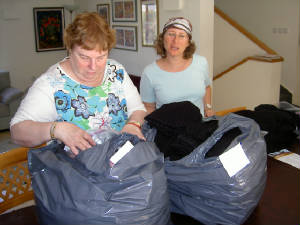
This project to knit wool hats for Israeli soldiers went worldwide. On behalf of OJOTC, Peggy Gurock (left) delivered a shipment of about 30 hats this summer to Chicks With Sticks founder Channah Koppel this summer in Efrat. It was the fourth shipment that OJOTC had sent to Channah since we became involved in the Chesed Project several months earlier. Channah reported that a total of more than 3,000 hats were distributed to soldiers the previous winter. The hats came from knitters all over the world. The hope was that by the following winter, she would have more than 4,000 more hats to distribute.
For more information, click here to read an article from Arutz7 about the project. It also contains the pattern to knit the hats.
Members were encouraged to get involved. Finished hats were shipped to Israel and members had the satisfaction of sharing in this mitzvah of helping an IDF soldier who is protecting our State of Israel.

